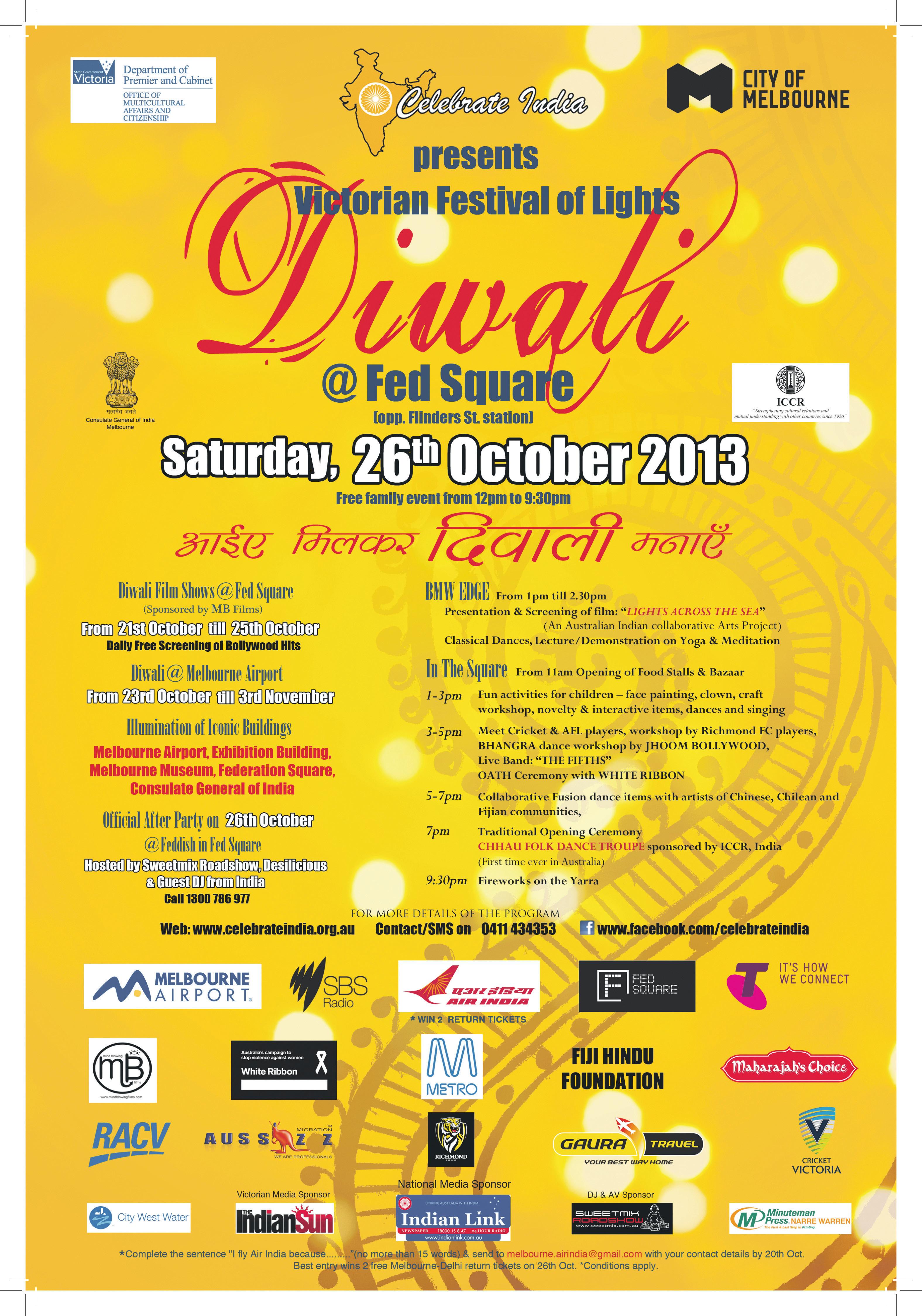









edit
INDIAN LINK
Pawan Luthra
EDITOR
Rajni Anand Luthra
ASSISTANT EDITOR











edit
INDIAN LINK
Pawan Luthra
EDITOR
Rajni Anand Luthra
ASSISTANT EDITOR
acceptance of why, at times, we needed to differ.
Lena Peacock
Sheryl Dixit
MELBOURNE COOORDINATOR
PAWAN PUBLISHER
Preeti Jabbal
CONTRIBUTORS
Nima Menon, Shraddha Arjun, Deepa Gopinath, Usha Ramanujam Arvind, Uttam Mukherjee, Jyoti Shankar, Deeksha Chopra, Debbie Ferns, Noel G De Souza, Mohal Dhall, Rani Jhala, Geeta Khurana, Avi Chandiok, Petra O’Neill, Kalyani Wakhare, Nancy Jade Althea
Vivek Trivedi 02 9262 1766
ADVERTISING ASSISTANT
Nitika Sondhi 02 9279 2004
DESIGN

Danielle Cairis
Proud member of:




Indian Link
Level 24/44 Market St, Sydney 2000 or GPO Box 108, Sydney 2001
Ph: 02 9279-2004 Fax: 02 9279-2005
Email: info@indianlink.com.au

www.indianlink.com.au
In October 2013, Indian Link newspaper begins its 20th year. We started as a 24-page black-and-white monthly publication with a print run of just under 1,500 copies. Today we are a fortnightly paper in Sydney (with combined monthly pages in excess of 140), a monthly publication in Melbourne, Adelaide, Brisbane and Perth with a combined print run of over 40,000. It has been a terrific journey! And this is in addition to our 11-year-old 24/7 radio station with live talk-back of over 8 hours a day, and a listenership of over 50,000. Our social media footprint across newspaper and radio enjoys over 6,000 likes, and our website with its regular news updates has over 17,000 impressions per month.
Of course, none of this would have been possible without our supporters who have maintained their faith in Indian Link, its philosophy and ethics. These supporters have at times been wholesome in their praise, caustic in their comments when they did not agree with our views, and mature in their
Our supporters range from a group of 70-odd writers who take time out from their busy schedules to report on an event, be it an arangetram or a conference on Gandhi; to radio anchors who fight traffic to get to their listeners at 7am, including the brave ones who juggle motherhood and domestic life while entertaining listeners on air. Our supporters also include our advertisers who have valued their link with a quality product that is consistent, reliable and ethical.
Indian Link has also been fortunate to have a strong team in editorial, content, creative, design, and sales and marketing, who have not only sustained us, but also understood our philosophy. Together they have worked long and hard to ensure innovative content and programming, which we have proudly taken to our own community and others in Australia. And the Indian Link mindset is very clear: to be able to provide excellent quality articles which inform and educate those who have made this country their new home. Our job has been to find all things Indian in Australia, to help us Indian Australians find a sense of achievement for each other, rather than absorb ourselves in petty
politics and envy which can so easily consume a small vibrant community.
We have reported regularly on issues relating not only to the IndiaAustralia equation, but also like every section of the Indian Australian community, including students, professionals, seniors, children, home-makers and those of GBLTQ persuasion.
We have shared success stories of some terrific work being done by Indian Australians, so that those coping with similar challenges can be inspired and know that all is possible in Australia. We have reported on community events with truthfulness, so that constructive feedback can be shared with the organisers. Our job has been to be truthful to our readers who are the ones we ultimately serve.
It is a privilege to serve the Indian Australian community and with their help we have built up a truly diverse media company, from humble beginnings to one which now has a national newspaper footprint, a radio station, online editions and a progressive social media platform. We look forward our journey together over the coming years.
















sPIRITUAL
shree shirdi sai Baba sansthan
sat 5 Oct 6.30pm: Sai Palki
sat 5 Oct-12 Oct 7.30pm-8.15pm:
Garba
sun 6 Oct 6.30 pm: Lalita
Sahasranam
sat 12 Oct 8.00 pm: Mata Chowki
sun 13 Oct Dussera/Satcharitra
Parayam
sat 19 Oct 10.45am Hanuman
Chalisa
All events will be held at the Sai Baba temple at 420 Liverpool Road, Strathfield.
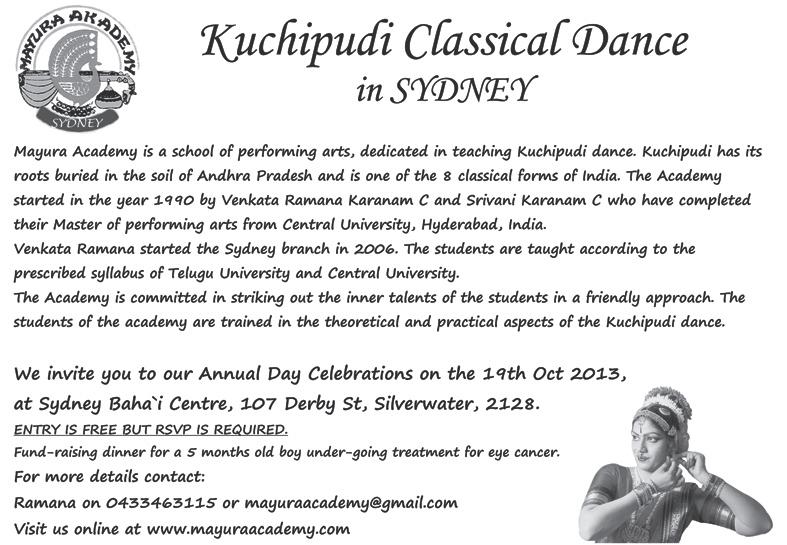
Details: www.shirdisai.org.au
1300 524 724 or saimandir@gmail. com
swami swaroopananda
free talk
Wed-sat 13-16 Nov
At Sydney Bahai Centre, Silverwater.
Details: Br Gopalji 02 8850 7400 or www.chinmaya.com.au
gopakuteeam
4th sun of every month
4pm-5.30pm
The Global Organisation for Divinity runs free spiritual education classes for children aged 4-12 years. At Crestwood Community Centre, Crestwood Drive, Baulkham Hills. Parents welcome to join in.
Details: Jayashree 02 9620 4676.
AWgP Balsanskar shala
BalSanskar Shala teaches children
Vedic slokas, Vedic maths, games, personality development, knowledge of great Indian personalities, and other aspects of Vedic culture.
Details: Gayatri Pariwar parijan Parag/ Niyati Wani 0421 403 852.
FEsTIVAL
Navratri Raas garba
sat 5 Oct 6.30pm (sharp) -11.00pm
Navratri Cultural Group (under the Auspices of Shri Shiva Mandir of Minto) announces action-packed Raas and Garba. Michael Wenden Aquatic Leisure Centre, 62 Cabramatta Avenue, Miller (Near Liverpool).
Details: Kanti and Pratibha Gokani 02 9792 1422.
Navratri garba Fri-sat 11-12 Oct
The Gujarati Samaj of NSW presents Navratri at Whitlam Leisure Centre, Liverpool.
Details: www.gujaratisamajnsw.org.au
deepavali Martin Place Thur 17 Oct 12noon-2pm & 5pm-7pm
The Hindu Council of Australia presents Deepavalai at Martin Place, Sydney CBD.
Details: www.hinducouncil.com.au
Caring & sharing diwali dinner & dance
sat 2 Nov 6.30pm
Fundraising event organised by GOPIO Sydney North West. Celebrate Diwali, while helping the underprivileged in India. At Bowman Hall, Campbell Street, Blacktown. Details: Harry Walia 0402842375 or www. gopiosydneynorthwest.com.au
MIsC
Odd socks day sat 4 Oct
Pull on your odd socks to show your support to a national antistigma campaign leading to Mental Health Week. Odd Socks Day is a light-hearted approach to reminding people that anyone can have an odd day.
Details: www.oddsocksday.org.au
Formal volunteering courses
Mon 14 Oct- Thur 14 Nov
The Ethnic Communities’ Council of NSW is introducing formal volunteering in mainstream organisations to two different groups of seniors who are 60 years and over: South Asians and the broader Asian community. Courses available are: a four-week course with 5 hours training once a week with the 3rd session to be an exploration of a one-off mainstream volunteering event; Course targeting South Asians will be held in Parramatta at ICE, 8 Victoria Road. Course cost: $850 including application for a national police check, but is FREE to 15 seniors from South Asian backgrounds. Details: 0401 512 494 or Caroline Romeo on 9319 0288 or www.eccnsw.org.au







 BY NIMA MENON
BY NIMA MENON


If the poor children cannot come to the education, then the education must go to them” said Swami Vivekananda.
September saw the beginning of a new chapter in the history of Ekal Australia. Ekal Woman was launched with great fervour and enthusiasm by a small team of volunteers whose sole aim was to rally the women in Australia behind a very noble cause. The High Tea organised at the Mercure, Parramatta saw women all dressed in different hues of pink, ready to pitch in to make this humble effort a roaring success.

Sumathi Advani, Chairperson of UIA’s Women’s Steering Committee and Aishveryaa Nidhi, a prominent theatre personality who has carved a niche for herself in the field of Australian theatre, addressed the audience and shared her experiences.
The entertainment included songs by Shobha Ingleshwar, Bollywood dance potpourri by Neha Jain and a fun-filled trivia. The afternoon showcased the Ekal cause with a short video and slideshow, highlighting the work done by Ekal Vidhalayas in remote tribal villages of India. The statics, though not overtly surprising, were staggering.
Most of the 300 million illiterate folk in India live in tribal villages that lack the basic amenities of life, like safe drinking water and basic healthcare. The literacy rate of the female population is as low as 39%, and only 10% of these villages have government schools. For families who survive on an annual income of $30, education for their children fades into oblivion. More hands on deck to increase their daily livelihood is the top priority. The existing schools are under-staffed with poorly paid teachers who are not motivated enough. Such villages are on Ekal’s road map.
The Ekal movement was started in India in 1986 by Rakesh Popli and his wife Rama Popli, with the intention of improving literacy at the grassroots level. The idea of the Ekal Vidyalaya, a single teacher school, caught the attention of the people and it soon became a global phenomenon, with Indian diasporas from across the globe sponsoring schools in remote regions of India. The best gift you can give any child is education, and that is what the Ekal movement endeavours to do.


Ekal Vidyalayas are different from traditional schools because the delivery of education is not regimented, but flexible. The schools are run free of cost, and when it is most convenient to their clientele, which would usually mean evening classes. This way, the parents have nothing to complain about. In fact, adults also participate in the educational
community. They learn about recycling and vermicompost. By selling the compost they prepare to local farmers, they generate income for the schools. The system the Ekal Vidyalayas put in place is a cyclic one, where every person in the village/community is benefitted and is a part of it, thereby taking ownership of it. They see purpose in the education meted out by the Vidyalayas.
Ekal Australia has been active since 2004 and has successfully earned sponsorships for 650 schools. Ekal Youth, which launched last year has so far raised $10,000 for school sponsorships.
Ekal Australia has been active since 2004 and has successfully earned sponsorships for 650 schools. Ekal Youth, which launched last year has so far raised $10,000 for school sponsorships
sponsorships of schools. The September launch was just the first step in a long and meaningful journey ahead. They hope to welcome more women into the fold to help it expand. In addition to this, they want the women of Australia to join hands to make a difference in the lives of those in India, and add to the fabric of an educated and prosperous country. As written in the ICPD Programme of Action, “Education is one of the most important means of empowering women with the knowledge, skills and selfconfidence necessary to participate fully in the development process”.

It’s October, which means it’s time to get ready for The Sydney Morning Herald Good Food Month presented by Citi, as it overtakes dining tables across Sydney, regional NSW, Canberra and Brisbane. Oh, and for the first time, there’s going to be a little sister food festival too, The Age Good Food Month, which will be held in Melbourne and regional Victoria in November.
Indian Link chatted with Festival Director Joanna Savill, as well as some of the chefs involved with the Sydney festival, including Ajay Mathur, Ajoy Joshi, Kumar Mahadevan and Nasir Siddiqui.
“It’s a celebration of great food and restaurants,” Joanna Savill told Indian Link “And is Australia’s
is a fantastic event which is an amalgamation of a variety of cuisines and restaurants
in both India and Australia.
“I accumulated a wealth of knowledge across various cuisines and have gathered a breadth of experience over the years,” says Ajay. “The culmination of this experience inspired me to open up my own restaurant, one which followed the meticulous training which I learned in my earlier years, yet celebrated my own history and Indian background,” he explains.
Ajay admits that he has a different outlook when cooking Indian food in Australia. “We have incorporated the healthy, low calorie, Australian way of life into our cooking by making leaner meals with reduced fat quantities,” he says. “Modern Indian Australian cooking is a lighter, healthier version of the traditional way of cooking Indian food. There is an emphasis on minimising the calorie content, yet we have incorporated modern Australian cuisine through our sophisticated presentation style of innovative dishes”.
However, it is helpful that there is such a wealth of fresh produce available here, that enhances the culinary experience. “Australia’s fresh local produce, and premium quality meat and seafood has allowed us to create more flavoursome dishes,” he says. “We use a number of fresh ingredients, such as blueberries, mung bean sprouts, snow pea sprouts, mesculan lettuce, fresh mangoes, raw papaya, beetroot, lime leaf, dill and chives. These ingredients would not generally be used in Indian cooking in India, yet we try and capitalise on the abundance of wonderful produce available to us,” states Ajay.
There is one signature dish for which Ajay is renowned.










“Barramundi Tawa Kebab is our signature dish. This is a combination of local seafood with traditional spices, ingredients and flavours, which summarises the innovation Bijolias strives to achieve,” reveals Ajay who is rather coy about sharing the recipe. Instead, Ajay invites readers to come and experience a night at Bijolias. “Our wide variety of Indian flavours fused with a modern twist, along with our monthly specials, offer an unusual gourmet journey to please the palates of a wide range of diners,” he claims. “Bijolias offers sophisticated Indian cuisine, out of the ordinary and sensationally modern, but the tools of the trade are age old in concept. It’s the style, ingredients, flavouring and delivery that sets it apart from any other,” he adds in conclusion.
“It’s a celebration of great food and restaurants,” Joanna Savill told Indian Link.


“And is Australia’s largest food Festival”

1kg whole chicken, skinned and cut on the bone into small pieces
1½ tbsp salt





2 cups sliced onions
½ cup vegetable oil



1 tbsp garlic paste

1 tbsp ginger
1½ tbsp green chilli paste
1 tbsp ground sesame seeds (tahini)
1½tbsp ground cashews
1tsp turmeric
For chef Ajoy Joshi, the Good Food Month festival is yet another opportunity to showcase his considerable culinary expertise. Having been an active participant in the festival since 2001, Ajoy has presented various themes and cuisines from India through the years, including Indian cooking classes and cooking with kids, among others. For this year’s festival, Ajoy intends to present four different types of distinct cuisine from India, from the metros of Hyderabad, Mumbai, Delhi and Chennai from the kitchens of Nilgiri’s, his restaurant in St Leonards.
“Each of these cities has a special style of cuisine and numerous dishes that are unique to it,” explains Ajoy. “Over four weekends during the festival, Nilgiri’s will present a dining experience from each of these cities, bringing out the flavours of their cuisine that has existed and been enhanced for centuries”.
Epicures will enjoy the best of Hyderabad through the Charminar Bazaar, which will present delicacies like the indomitable biryani, as well as local dishes like Pathar ka ghosht, nehari (slow cooked lamb) and bakarkhani (royal bread). The Bandra Festival that is dear to all Mumbaiites will have the inevitable Chowpatty chaat, Kolhapuri mutton and Kolivada fish. Purani Delhi will offer the best in kebabs and parathas; and Pondi Bazaar will present a selection of seafood dishes true to the region, as well as the Kanjeevaram idli
“We have a balanced selection of vegetarian and non-vegetarian dishes, and our signature dosa for which we are renowned, will feature throughout the festival,” says Ajoy. To ensure a fitting conclusion to the dining experience, a selection of
Indian sweets from each region will be on offer.
Nilgiri’s will certainly be on the route of gourmands looking for an exciting array of Indian cuisine. But then, the restaurant has been operating since 1997, and is extremely popular with a regular and loyal clientele comprising of local Australians, as well as those of Indian origin.

“When I started out in the food industry in Australia, Indian food wasn’t even considered as a cuisine,” says Ajoy. “A ‘curry’ was what constituted Indian food”.
My aim was to demystify the cuisine and to take it beyond this concept. I am happy to say that at Nilgiri’s we have succeeded in doing just that. My patrons now know that Indian cuisine is varied, comes from different regions and that each dish is prepared using specific ingredients that are put together for a reason,” he adds.
“In my cooking classes, I emphasise the use of certain spices such as the use of haldi (turmeric) or green chillies, to educated attendees on the reason why these spices are used in certain dishes. There is a reason behind the combination of spices that gives food from different regions in India their distinct flavour. Indian cooking has been evolving since 4,000 years, and it will keep evolving,” states Ajoy.
He is delighted that the perception of Indian cuisine has changed dramatically now, and that epicures of fine dining even recommend certain wines that compliment different Indian
spice, the essence of each recipe remains unchanged. That’s what makes Nilgiri’s so attractive to people seeking an authentic Indian cuisine,” he adds.
For Ajoy, introducing patrons to the various regional cuisines of India is also a challenge, but an interesting and rewarding one. “It is important for people to know that different regions enjoy diverse dishes, and I try and make them aware of this through themed cuisine each month. In November, we aim to present Kashmini cuisine, with a combination of the best of Hindu and Muslim dishes,” he says.
Years of experience working in the hospitality industry as a chef in renowned hotels, as well as owning restaurants individually, or in partnership in India and Australia, have put an edge of finesse to Ajoy’s cuisine. That he is passionate about his restaurant and its offerings is obvious, and the testimony to this exists in the success of Nilgiri’s. Ajoy is certain to enjoy wide patronage during the Good Food Month festival, and it is hoped that his array of regional cuisine on offer, apart from enhancing the tastebuds of his patrons, also entices them into experiencing the various regional dishes and flavours that make India a conglomeration of fascinating cuisines.


To share the Good Food Month culinary experience at home, try one of Ajoy’s signature dishes


2 tbsp poultry garam masala
2½ cups full-fat yoghurt
1 tbsp lemon juice
½ cup chopped mint
In a mixing bowl, add 1 teaspoon of the salt to onions and mix. Heat oil in shallow frying pan. Add onions to caramelise and set aside.
For the marinade: In a clean mixing bowl, add garlic, ginger and green chilli pastes. Then add, one at a time, sesame seeds, cashews, turmeric, garam masala, remaining salt and yoghurt. Fold together. Add the chicken to the marinade and rub marinade onto the meat. Set aside for about 15 mins. Place marinated chicken in a large saucepan, making sure that the meat only takes up onethird of the saucepan space (this allows the steam in the rest of the pan to cook the chicken). Place frying pan on medium heat. Let pan heat up, then place the contents into frying pan. Cover pan with a heatproof mixing bowl. Reduce heat and add half
a ladle of water to mixing bowl. Cook chicken until all the water in bowl has evaporated (about 50 mins to just over 1 hour). Remove lid and sprinkle with lemon and mint. Serve with a bread of your choice.
Chef Kumar Mahadevan’s theme for the Good Food Month festival is ‘Let’s do Lunches’. But it’s not just ordinary lunches that this talented chef, a veteran in the business, intends to prepar for patrons of his two renowned restaurants, Aki’s and Abhi’s.

Kumar will create a feast of Italian food, featuring cuisine from the Campania region in south Italy for patrons, a move away from the traditional Indian cuisine that is the hallmark of his awardwinning restaurants.
To celebrate the 10th anniversary of Aki’s restaurant in Woolloomooloo in the same month, he will present a degustation menu.
Aki’s was awarded a Chef’s Hat in The
100mls sunflower oil
Whole garam masala
3 bay leaves
1 inch cinnamon stick
6 pods green cardamom
9 cloves
1tsp mace threads or powder


2 Spanish onions
11/2 tbsp ginger paste
½ tbsp garlic paste


3 tomatoes
½ tsp turmeric
1 tsp chilli powder
1 tbsp coriander powder
11/2 kg goat meat with bone
5 sprigs fresh coriander leaves
Heat the oil in a casserole dish over a low to medium heat and add the whole garam masala, except the mace. The mace will be added right at the end. Once the whole garam has released its aroma, add the sliced onions and cook till the onions are golden brown. Add the
garlic paste first and cook for a minute. Add the ginger paste and the powdered spices and cook for a couple of minutes sprinkling some water (1 tbsp) in order to stop the powdered spices from burning.
Add the tomatoes and let the tomatoes work with the powdered spices till you see some oil separation around the edges. Now add the diced goat, and season with salt. Coat the meat with mixture and stir for a further 5 mins till the meat releases its juices. Now add a litre of water and cook over low to medium heat for an hour and a half. Check for the consistency of the sauce (should not be too thin). Add the fresh coriander leaves (4 sprigs) and the mace powder and remove from burner.
Sprinkle with fresh coriander leaves for garnish before serving. (A slow cooking process will ensure tender meat).
says Kumar emphatically. “I don’t create local versions. What you get is actual Indian food the way it is prepared back home. This is the testament of my culinary expertise, I never compromise on the taste and authenticity of the menu. So if you order sambar, you will get exactly the same dish that is prepared in, say, Chennai,” he adds.
This, says Kumar, is the main reason why both his restaurants are popular among Indians and
non-Indians alike, and have been for since the past 25 years, with the creation of Abhi’s in North Strathfield.
Kumar is no stranger to the Australian cooking scene, having appeared on cooking show Masterchef, and having more recently published his first cookbook titled From India: food, family and tradition
Kumar began his tryst with Indian cuisine from an early



Australia in 1985 to work, and was soon heading up the kitchen at the highly regarded Mayur restaurant, where he cooked for the likes of Prince Phillip and Mick Jagger.
Kumar has taken his natural flair for the combination of







and contemporary aspects of Indian food.
Kumar is particularly proud of his recently released cookbook, which presents traditional and modern recipes alongside his personal story of arranged
marriage, international adventures and his and his wife’s ultimate move to Australia. Recipes are arranged according to their taste, ‘sour,’ ‘sweet,’ ‘salt,’ ‘bitter’ and ‘spice,’ perhaps emphasising the Vedic concept of six tastes.
Among the many signature dishes that are presented from Kumar’s kitchen, the most special ones are Patrani machhi, which consists of an exquisite fillet of wild barramundi wrapped in banana leaves and steamed with fresh mint, coriander, ginger and lime; Palak patta chaat; Double ka meetha, a sweet dish; and Railway Goat Curry, which the chef shares with us (above).
www.indianlink.com.au
Good Food Month is also joining forces with Parramasala and Taste, to highlight Indian food in Parramatta. Nasir Siddiqui and his team from Haandee Restaurant are thrilled to be a part of the festival. “We are very excited about our involvement in the Parramasala feast because it is one of the premiere events for the Indian community,” says Nasir. At Parramasala, along with involvement from other restaurants in the area too, there will also be a Chai Temple, Indian food markets and a vibrant street parade to spice things up in the city of Parramatta.
“This year, we are planning a couple of specialities for the festival,” says Nasir. “One of them will be our Parramasala meal deals, and the other will be our grill specials night at which we will serve our signature dishes such as chicken tikka, seekh kebab and seafood items all cooked on charcoal”.
The cuisine at Haandee Restaurant is traditional Pakistani-Indian cuisine, and has been running for a few years now on Church Street, in the heart of Parramatta. The team who all hail from Punjab, collectively have over 20 years of experience in Indian and Pakistani cuisine.
“We believe that Australia in particular has been very






Parramasala Feast, Parramatta
Join the taste team on a progressive dinner through the markets of the Parramasala Festival. Dinner includes a take home treat and traditional non-alcoholic drinks.
Where: Parramatta
When: 6-9pm October 4
generous and accommodating to cuisine from all over the world, especially food from the Indian sub-continent area,” says Nasir. “People here have developed a strong bond and association with Indian food, which has allowed hundreds of Indian restaurants and outlets to flourish and prosper. We believe that Indian food has been positively influenced by Australia, with so many dishes using great Australian produce, like lamb and other key ingredients,” he avers.
When asked about the differences between Indian cuisine in India and what’s on offer here in Australia, Nasir says, “every cuisine including Indian, has a certain taste, which should be original and consistent across geographical boundaries. Most of our dishes are prepared and served in the same way as they would be in most parts of the Indian sub-continent”.
And of modern IndianAustralian cooking, Nasir explains, “it is a blend of Indian spices and ingredients used in a mild and gentle way. This genre of modern cuisine has been influenced by the easy availability of most of the ingredients and spices that were not found here a decade or two ago. These days, I can’t think of any ingredient that we use in any of our recipes, that is not used in Indian food”.
According to Nasir, Haandee has two special signature dishes, chicken karahi and mouthwatering haleem, which are both on the festival menu. These will certainly be worth tasting, as they reflect not just the essence of the restaurant, but also a taste from back home.
a bliss F ul nig H t at b i JO lias
a five-course rajasthani meal which includes a dessert, indian Kulfi and cup of masala chai and glass of sparkling wine.
Where: bijolias, shop 5/540, sydney road, seaforth
When: 5.30-10pm October 15
Dusse H ra & Diwali: Celebrate t H e i n D ian Festival OF l ig H ts at n ilgiri’s
Celebrate Dussehra and Diwali with a regional sunday buffet for lunch and dinner.
Where: 81 Christie street, st leonards
When: October 6, 13, 20, 27





tH e i n D ian rOyal aFFair
experience the old fashioned indian village ways and customs while enjoying live classical music with pre-drinks and canapes. includes masala chai, coffee, traditional lassis, soft drinks, beer and wine and a maharaja’s goody bag.
Where: 14 Douglas road, Quakers Hill
When: 5-10pm October 19
10t H a nniversary OF a ki’s Fine i n D ian Cuisine an D Fine w ine O n tH e wH ar F will be a menu of traditional coastal indian cuisine paired with some great wine styles from around the world.
Where: 1/6 Cowper wharf road, woolloomooloo wharf
When: 7.30-11.30pm October 31
BOOKINGS AND MO re eve NT LISTINGS : sydney.goodfoodmonth.com
“these days, i can’t think of any ingredient that we use in any of our recipes, that is not used in indian food”
Nasir Siddiqui
Indian food has fascinated Australian chefs for some time now, and is only growing in popularity. But what is it about this cuisine that attracts Australian chefs? Matt Moran, Curtis Stone, Christine Mansfield, Kurma Dasa are just a few of the many Australian chefs who have been caught up in the flavours of Indian cuisine from its myriad of regions.
For Mansfield, a lover of Punjabi food, it is one word that keeps on bringing her back to India and Indian cuisine, and that is ‘spice’. Her first trip to India was in the mid 1990s when she was invited to be a guest chef at a restaurant there. “That was the starting point of a life-long love affair,” admits Mansfield to a source. “It’s a country I just ‘got’. It got under my skin!” She now has “an enduring emotional connection to its beguiling, seductive and addictive flavours”. Mansfield is one of Australia’s most celebrated chefs, and is considered to be one of Australia’s culinary experts on India cuisine. She is an author, food writer, food manufacturer, presenter, teacher, gastronomic traveller, and is even doing a one off event as part of the Good Food Month. Some of her books include Stir, Spice, Christine Manfield Originals, Christine Manfield Desserts, Fire - A World of Flavour, Lantern Cookery Classics, Fire & Spice and Tasting India.
Another lover of Indian cuisine is one of Australia’s celebrity chefs, Curtis Stone, who has

numerous cookbooks and television shows that showcase his talent. “I love Indian food!” he says with undoubted enthusiasm. “I have cooked Indian food too, but to me authenticity is very important with regards to cuisine,” he reveals. Which is why he went to the source to learn how to cook it. “A cuisine represents a culture, and in India the culture is so vast, with so many languages, religions, geographic and climate conditions... these differ from place to place, so there is a lot for me to learn,” says Stone.
Kurma Dasa on the other hand, was drawn to Indian food, and in particular vegetarian cuisine, by his first experience of the food prepared in the kitchens of a Hare Krishna temple in Sydney’s Paddington. Dasa began his career as a chef in these kitchens by cutting vegetables, grinding fresh herbs and spices and assisting in the preparation of their wellknown Sunday feasts. Since those humble beginnings, Kurma has gone on to teach his own style of stylish and eclectic gourmet vegetarian cuisine.
Dasa describes his style of cooking in three succinct words, “Vedic vegetarian cooking,” where the process of creating dishes is an act of devotion. Dasa was the head chef at Melbourne’s vegetarian restaurant Gopal’s for many years, and is the author of numerous cookbooks, including Great Vegetarian Dishes, Cooking with Kurma and Quick Vegetarian Dishes He has over a million books in circulation, which have never gone out of print, and has even had
his first cookbook translated into Farsi, the language of Iran, which is quite an accomplishment. Dasa has appeared on television cooking shows and currently teaches cooking classes.
Both Dasa and Mansfield question what contemporary Indian cuisine could actually be, because the nature of Indian cuisine is regional. “Australians might have a very narrow perception of what Indian food is, but there is enormous regional variation,” says Mansfield. “It would be great to see those variations translate into a separate restaurant cultures in Australia”. For Mansfield, Indian food is all about “the balancing of flavour and texture as well”.
Dasa believes that Indian food on the lower end of the spectrum is never quite as good in Australia, as it is in India. He recommends the Hare Krishna experience for quality Indian food in Australia, at the organisation’s new centre on Sydney’s Broadway, near the University of Technology Sydney; or Govindas in Darlinghurst, which he describes as true contemporary Indian-Australian food (if there is such a thing). Or for those who live in Queensland, there are many Hare Krishna places to eat which are doing a great job of popularising vegetarian Indian food in Australia.
“You do get Indian food in Australia, but it’s not the same; it’s spicier and more fragrant in







India,” says celebrity chef Matt Moran, co-owner of ARIA restaurant in Sydney and Brisbane, ARIA Catering, Chiswick Restaurant, Riverbar & Kitchen, and Opera Bar. He is also host to several TV shows including From Paddock to Plate. “That’s because the ingredients are fresher,” says Moran, of Indian cuisine. Savouring the flavour and cooking with local produce is a mantra by which Moran swears by.
“A lot of Indian food is timeless because it has such a strong, ingrained tradition,” says Mansfield. But “even in India, the food that you get for tourists is very different to the authentic experience”.

“Australian cuisine is very relaxed and has multicultural influences, including those from Asia and Europe,” says Stone.


“Indian cuisine has complexity, and the balance of spices for particular dishes in particular regions is a major factor in India.”
Curtis says that a number of Indian dishes including daal-baati, biryani and chicken tikka are among his favourite dishes.
When asked about what his favourite dish is, Dasa quickly answered with khichari, an every-day comfort food enjoyed throughout India, which is a nutritious combination of rice and dal with various seasonings including fresh coriander, turmeric, fennel, chilli and more. In some regions the steaming hot
Kurma Dasa on the other hand, was drawn to Indian food, and in particular vegetarian cuisine, by his first experience of the food prepared in the kitchens of a Hare Krishna temple in Sydney’s Paddington
dish is served with a dollop of ghee (clarified butter) on top. The dish almost transcends all regional barriers, and he has done justice to the dish by including the recipe in all three of his books. It is a wonderful thing to eat at any time of the day.
“India is a visual feast and a gastronomic paradise, seducing with its food and contagious hospitality. Modern India has 29 states, each with distinctive food,” states Mansfield. “The Indian table is an extraordinary feast for the senses, spices are to the tastebuds what colour is to the eyes, and the symphony is magical and powerful,” she claims.
MELISSA TWIST takes a closer look at some top Aussie chefs and their relationship with contemporary Indian-Australian cuisine






Icelebration as 350 attendees to the Ganesh Festival 2013 venerated Lord Ganesha at the Ermington Community Centre in Western Sydney. Indian cultural organisation Australian Telangana Forum (ATF) was instrumental in gathering Telangana people, especially from Hyderabad, to join them on the auspicious occasion in September.
The free event began at around 2pm with a priest performing the Saamoohika Ganesh pooja (combined prayer) with 30 families in attendance. The idol had been brought from India and had been created using only natural material, donated by one of the patrons of the organisation.
In parallel, about 30 children participated in a competition to make idols of Lord Ganesha, using clay. Prizes were distributed to the top three winners of the best idol, while all the children present were presented with pooja pens. The committee conducted this event to showcase India’s

the deities best known and most widely worshipped in the Hindu pantheon.

Next up was the cultural section, which highlighted the traditional arts of India through classical vocal and dance performances, which were sincerely applauded by an appreciative audience.
The procession leading to the Ganesh visarjan (immersion) ceremony is an integral part of the festival celebrations, and this was symbolically conducted with joy and chanting within the confines of the venue.
Another highlight of a successful evening was the Hyderabad tradition of the Ganesh laddoo auction. The Ganesh laddoo is a sweet that is made out of yellow split peas, sugar syrup and other ingredients, and is specifically offered to Ganesh at poojas in Hyderabad. It is considered as auspicious to the home, particularly to business people. Auction of this laddoo is a popular
tradition in Hyderabad. At the event, the Ganesh laddoo auction began with a bid of $499, and soon crossed last year’s record of $700. Finally, Sagar Group and Western Chargers Sports Club together secured the laddoo with a winning bid of $1,550. A smaller laddoo meant for children was secured by Neil Reddy Karri and Nikhil Reddy Karri with a winning bid of $250. The entire process of the laddoo auction filled the venue with cheer and excitement, with cries of “Jai bolo Ganesh maharaj ki...Jai” resounding throughout the hall.
Following the auction, dinner was served to all participants and ATF’s biggest event Bathukamma Festival 2013 was announced, which will be held at the same venue on October 12.

ATF President Mr Madhav Katikaneni, along with his executive committee team made this event a very successful one. Addressing the audience, General Secretary Mr Venkata Prasad Ragipani said that Australian Telangana Forum represents all
Australian Telugu speaking people mainly from Telangana. “This festival showcases the integration of our cultural heritage into multicultural Australia,” he added.

The ATF thanked all EC members, ATF members and all





the guests who contributed. The event concluded at 9pm, following the visarjan of the Ganesh idol as per tradition. Details of upcoming events: www.australiantelanganaforum. org.au


The evening of September 21 at the Whitlam Centre in Liverpool was a festive one, as people dressed in brightly coloured traditional outfits thronged the floor to dance the dandiya and garba to the music of worldrenowned music maestro Devang Patel. Organised by Krishav Events, the company’s debut event titled, the Devang Patel Dandiya 2013 created history with a record of 2,500 of people attending from all corners of New South Wales.
“The dandiya was a historic event for many reasons,” said an ecstatic Chintan Trivedi of Krishav Events, the main organiser of the event. “Apart from the attendance, which was the highest to such an event so far, for the first time ever here, an Australian singer performed in the Gujarati language. It was an instant hit, people absolutely loved the band Electric Korma!”
Electric Korma, a selfproclaimed Hindi-rock band with their own unique genre of music created a sensation at the event, particularly with their rendition of Pankhida o Pankhida. Mr Trivedi sourced the band and was largely responsible for their participation at the event.
Devang Patel and his team performed aptly as expected, with the crowd enjoying traditional and filmi tunes, swirling and whirling to the various rhythms and crescendos of the music.



What was unique and innovative about the event was that it was broadcast live via the Keshav Events’ website, for those unable
to attend to view and enjoy. In addition to the festivities was the offer of chances to win vouchers worth $800 on each ticket that cost just $15, for solar or migration services, clothing, beauty and dinner, and even pizza and panipuri! The catering by Darbar and Annapurna
restaurants was enjoyed by attendees, who took time out from the activity to refuel with some mouth-watering Indian delicacies. There was even a professional photography studio at the venue, operated by Evergreen Photography, which could capture special moments for the attendees.
All in all, the event was a grand success, not just for Krishav Events organisers Chintan Trivedi and Pathik Vora, but for all the 45 sponsors who had supported the event. But the main measure of success was through the reaction of the attendees who were happy, satisfied and tired by the end of
the show. Mr Trivedi thanked sponsors and volunteers who had contributed to the success of the event. Kudos to the Krishav Events for putting up a well-managed traditional event that highlighted one of India’s great festivals and contributed to multiculturalism in Australia.
2013 PARLIAMENT OF NSW MULTICULTURAL MEDIA AWARDS
Coverage of Community Affairs Abroad

Online Innovation in News Blog or News Website Design
2013 NSW PREMIER’S MULTICULTURAL MEDIA AWARDS
Best News Report



Best Online Publication of the Year




Best Image of the Year
Finalist in 7 of the 10 categories
2012 PARLIAMENT OF NSW MULTICULTURAL MEDIA AWARDS
Multicultural Journalist of the Year
Editorial / News Reporting
Online Innovation in News Blog or News Website Design


2011 NSW PREMIER’S SUbCONTINENT COMMUNITy AWARDS
Harmony Award
An Aussie singer and band, unprecedented crowds and loads of prizes made the dandiya show an exciting one

The seventh OzAsia festival opened, literally, with a bang to the beat of seven drums and two large gongs in the opening act of Meeting with Bodhisattva. The huge drums took me back to the opening ceremony of the Beijing Olympics and even further to the famous Tamil movie Chandralekha (1948). In it a bevy of beautiful girls dance on top of some fifty massive drums, a scene bigger than Ben Hur. The venue was Her Majesty’s Theatre, a neo-classical building that has just celebrated its centenary, and was appropriate to hold this event.
Although the play is based on a classical theme, it is presented in a modern ballet format. In essence it expresses a “journey of a man facing his fears as he enters unknown territories; a journey from questioning everything to accepting anything that happens to him for better or worse”. There is no dialogue. It is left to the audience to understand the Buddhist mantra, “get rid of impurity and relinquish the dualism that divides thought and action”. This dualism is well brought out by an interesting mix of contrasts, non-stop movements by characters and moments of absolute stillness; billowing sound of drums and stony silence; waving long sticks in threatening gestures and gentle tai chi-like movement of limbs; soul-stirring music but no lyrics; constant flow of messages through body language, and yet hardly any words.
This unique presentation by Taiwan’s U Theatre features sixteen dancers who slice through the air, striking their instruments, drums, gongs and cymbals, with immaculate precision. The sixteen players, seven women and nine men, are all attired in uniformly looking long off-white robes; it is hard to tell them apart from a distance, except for the bun-like hair-dos of the women. They seem super-fit and yet supple as the 90-minute show demands constant movement of the players, especially the central character.



prancing, jumping, and twirling, while at the same time waving his stick in mid-air, tapping the floor and hitting the drums. At times he uses his staff to fend off others who seem to attack him with long sticks. This is very much like the silambattam in Tamil Nadu, where similar fight scenes were once seen in rural areas. It is also akin to certain Japanese stick play I saw a few years ago. When Buddhist
to foreign lands to spread their message, they were instructed not to harm any attackers, but defend themselves with their sticks and other forms of martial arts which later took deep roots in those countries, giving the impression that they originated from there.
The stamina of all players is phenomenal in this immensely physical tale of the search for
inner calm amongst chaos. In the last but one scene, all of them whirl round and round, like the Dervishes of Turkey, for almost an eternity, to the accompaniment of soulful music in slowly dimming light.
The seven acts move seamlessly with no curtain drop. The huge drums and gongs are moved in and out on special skates, without a squeak. In the entire play only three words are uttered. The
Bodhissattva is a beautiful blend of athletic drumming, Buddhist chanting, martial arts and meditation where the players’ bodies act out a language both religious and artistic, as the drums and gongs fill the hearts of the audience with a sensual and spiritual feeling. It is a unique narrative of one man’s chance meeting with a deity whose only way to wisdom is through letting go.

The winners of the prestigious 2013 ART Music Awards in Australia were announced recently, and the Performance of the Year award was won by Chennai-based mrudangam maestro, Guru Kaaraikkudi Mani’s Sruthi Laya Ensemble and members of the Australian Art Orchestra, for their thrilling performance of Sandy Evans’ music recording Meetings at the Table of Time, created in India. This unique work is a coming together of both Western jazz and Carnatic music, and creates a performance of depth and integrity. The winners were announced across 11 national categories and seven state categories at the 2013 ART Music Awards, held recently at a gala function at the Parade Theatre, NIDA in Sydney. Hosted by APRA AMCOS and the Australian Music Centre (AMC), the ART Music Awards are the only national events in Australia to acknowledge the extraordinary achievements and creative successes of Australian composers, performers and educators in the


genres of contemporary art music, jazz and experimental music.
“This award is… most often won by western classical orchestras, so it was a great tribute to Guru Mani and Sruthi Laya that our performance was recognised in this way,” said Sandy Evans. “Of course people in India wouldn’t be surprised by this, but in the Australian context as you well know, it’s quite revolutionary!”
While APRA AMCOS and the AMC congratulate all the 2013 ART Music Awards winners on their outstanding achievements, Australian Carnatic musicians and art lovers of fine arts are extremely proud of this achievement. The far-reaching vision, mutual respect, relentless and innovative pursuits by Sandy Evans and Guru Kaaraikkudi Mani and his team have created this milestone.
This is another record-breaking news of pushing boundaries in music and building bridges between Australian contemporary music and Carnatic music.
Ravi M RavichandhiraPerformance of the Year

 BY DEEPA GOPINATH
BY DEEPA GOPINATH
In this hectic modern-day world, a creative outlet is not only helpful, but necessary as a stress reliever. Whether it is the visual arts, music, dancing or any other artistic endeavour, when we lose ourselves in an art form, everything else fades away.
Hamsa Venkat, through the Samskrithi School of Dance, gives dancers the gift of a creative outlet. A talented dancer in her own right, Hamsa trains and nurtures her students in the South Indian dance form of Bhrathanatyam, while juggling a job as an English teacher and caring for her own family. Despite her other commitments, passing on the knowledge of the art form is something very dear to her heart. Learning such a structured art form brings with it the joy of creativity, but also other life skills such as confidence, discipline and social skills.
In addition to regular classes, students perform in at least one of the school’s bi-annual concerts. The first of these for the year is geared towards providing junior students with the on-stage confidence and exposure they need to blossom into performing artists. Participation in these shows is an important part of a dancer’s development.

“Performance is a commitment and it drives students to improvement,” according to Vidhya, who has been learning with Samskrithi for the past eighteen months.
The joy that comes with learning this elegant art form shines from the faces of Vidhya and her classmates, Bhavani and Manju. All three are mothers of young children who moved to
Sydney from India, as newlyweds. The three have in common the fact that they learnt Bharathanatyam in their home country more than fifteen years ago. They have sustained their love of the art form through the years, but never did they imagine that they would have the opportunity to not only learn again, but to perform in Australia. Dance has given them the gift of a sense of self, and an opportunity for personal achievement outside of their careers and family commitments.
For the younger students, the enjoyment of dance has a simpler, but equally significant basis.
Sahana (10) learns Carnatic music and another dance form, Kuchipudi, as well as Bharathanatyam. She values the exercise and athleticism that comes with learning dance. Having learnt dance since she was 6, the opportunity to learn and perform a diverse repertoire is something that Sahana appreciates in Hamsa’s style of teaching.
Varsha (13) attends class with her sister Jyothi and they hope to perform their arangetram (solo debut performance) together one day. In a very mature way, she explains that there are limited opportunities for exposure to Indian culture in
Australia (compared to India), and dance is one way in which they can connect with their culture. Through dance, the girls have learnt much about Hindu mythology. After all, natya, or the act of storytelling, is one of the main aspects of Bharathanatyam Hamsa makes great efforts to explain each story they are enacting to her students, making it easier for them to be expressive through dance.
Varsha and Jyothi’s mother Madhu agree that the discipline provides her girls with focus and promotes pride in their culture. They not only enjoy a creative outlet outside of school, but have the chance to make long-lasting friendships within the community. Madhu adds that Hamsa has a way of drawing the best out of her students, one of the qualities that makes her a wonderful teacher.
And like many teenage girls, when asked what is her favourite part of performing, Varsha’s reply is “the costumes!”
What makes this annual production unique is the involvement of young musicians, many of them senior students of Samskrithi School of Dance. Devika, a talented dancer and vocalist, was part of the musical
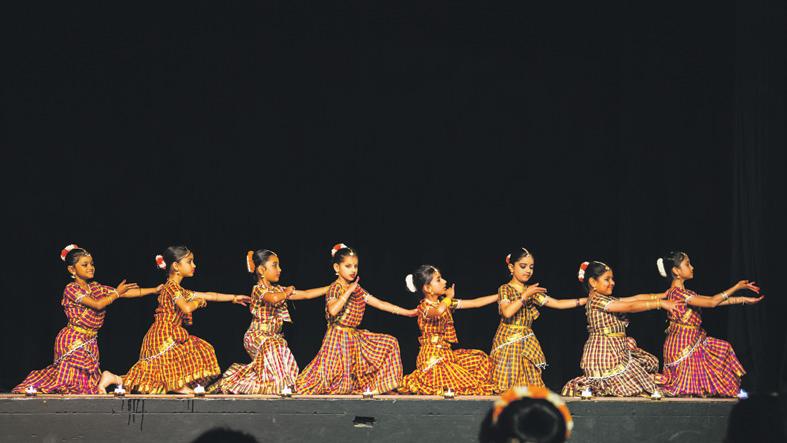
line-up. Being a dancer allows her to more effectively lend her silken voice as an accompaniment to the dancers, and she considers herself blessed to have the opportunity to be involved in so many aspects of this beautiful art form. One of the challenges of singing for dance is the need to follow a specific structure that accompanies the choreography. Through her own dedication, her mother’s tutelage as well as the methodical approach of Hamsa, Devika is emerging as one of Sydney’s most talented young classical dance vocalists.
Each year, many other senior students of Samskrithi also pitch in to help keep the order backstage, ensuring the show runs as smoothly as possible. This collaboration between the Guru, dancers, senior students, other artists and parents of the dancers is what makes Parampara such a success! The role that such opportunities play in building a young artist’s confidence is invaluable, and the satisfaction it brings to all involved is beyond measure. Dance is a without doubt a creative outlet but it is so much more. As Hamsa Venkat says, it is not only a representation of life, but it is life itself.
In a very mature way, she explains that there are limited opportunities for exposure to Indian culture in Australia (compared to India), and dance is one way in which they can connect with their culture
And like many teenage girls, when asked what is her favourite part of performing, Varsha’s reply is “the costumes!”








Through the guidance of Hamsa Venkat, students express their creativity in classical Indian art forms


 BY USHA RAMANUJAM ARVIND
BY USHA RAMANUJAM ARVIND
Intrinsic to human nature, the Nava Rasas, or nine primal emotions have been the codified in many ancient philosophical treatises, the most notable among them being Sage Bharatha’s Naatya Shaastra Classified as shringara (romantic love), karunya (compassion), adbhuta (awe/wonder), haasya (laughter/mirth), veerya (valour/ heroism), bhaya (fear), bibhatsa (disgust), raudra (anger/fury) and ultimately shantha (peace/ equanimity), together represent the myriad strands that constitute a complete individual.
Over the course of the centuries, repeated attempts have been made to unlock, understand and portray the nuances of these central emotions and their responses through various art forms. For the experienced artiste, Rasas are a veritable repository, offering both a blank canvas and the poetic licence with which to experiment.
Dedicated to the cause of making Bharatanatyam accessible to the wider community, Manjula Viswanath, who follows the Vazhuvoor tradition, has for the past two decades choreographed many successful productions. Her latest dance ballet Navarasa Bhaaratha is a fitting homage to Bharatha Muni’s rich legacy that also effectively inculcates these nine primal emotions into a stellar performance.
The ballet, which was performed by the students of Rasika Dance Academy at UNSW Science theatre, raised $25,000 for Sri Venkateshwara Temple (SVT) in Helensburgh. The monies raised will be invested in social enterprise and educational ventures undertaken by SVT.

“The concept of rasas or emotions is an outstanding contribution of Indian culture to the world of art and literature. Earlier this year, while contemplating my next show, I was challenging the way I perceive dance to come up with something unique, that I had never done before. Thus came the Eureka moment and Navarasa was born,” Manjula said, explaining the origin of the concept to Indian Link
Once past the drawing board stage, Manjula took her concept to veteran musicians Balasubramanya

Sharma and Prof Sudha Ravi back in India to compose the original score and lyrics. Scene visualisation and choreography followed.
“I also had to select my students aptly to portray these nine characters who are the embodiment of nine emotions, or nava rasa. Putting theory into practise, my students followed my every move as I enacted every step, every emotion while explaining to them what it all meant. I am proud to say my students fulfilled my high expectations of them,” she added proudly.
For Manjula and Rasika Academy, Navarasa Bharatha has been quite a journey of selfdiscovery.
“While walking through each rasa, I also walked through my own childhood, when my grandmother would narrate powerful stories to me. In today’s world this is becoming a lost art and I felt it’s important to convey this to the audience through dance,” she explained.
Tapping into India’s vibrant multicultural history, Navarasa Bharatha explored the intricacies of the human emotional repertoire, weaving a sumptuous tale in the process. The dance drama, which cleverly integrated strong narrative techniques with traditional Bharatanatyam principles, appealed instantly to audiences young and old. As the stories unfolded, there was never a dull moment. Plenty of colourful costumes, skilful lighting arrangements and props added depth and dimension to the show.

The Rama Setu scene depicting adbhutham, for instance, was quite a feat. Not only were the props and costumes apt, the dancers with their supple movements and distinct abhinaya clearly stole the show.
Frame after frame followed seamlessly, with the junior students not only introducing the themes, but also providing the perfect
backdrop for the action to unfold. The spotlight then turned on the more experienced performers (Madhumitha, Anjana, Sandhya, Shruti, Shalaka, Vaidehi, Anitha and Abisri) as the recurring themes were delineated in greater detail. This talented core group not only excelled in dramatic prowess and emotive abilities, but were also true to the fundamental values of Vazhuvoor style of Bharatanatyam, subtle abhinaya, elegant postures and graceful movement. Each of the nava rasas was represented through a colourful story, thoughtfully chosen and succinctly portrayed, the pristine beauty of young love in Kalidasa’s Shakuntala and Dushyantha (shringara), wit and humour of Vikatakavi Tenali Raman, the court jester of Vijayanagar empire (haasya), the all consuming rage of Kannagi, immortalised in the Silappathikaaram (raudram), the Mauryan emperor Ashoka’s revulsion at his self destructive greed (bhibatsya), empathy of Gautham Buddha towards all human suffering (karunya), fear of authority (bhaya) exemplified by Purandara Dasa’s wife Saraswathi Bai, heroic valour of Chatrapathi Shivaji (veerya), awe inspiring feats of Hanuman as he strives to achieve the impossible (adbhutha) and finally, overwhelming sense of peace and tranquillity attained by Vasavadatta.
While adhering to the broad parameters of Bharatanatyam, Manjula also incorporated strands from other celebrated art forms like Kalaripayatu or martial arts (war scenes of Veerya and Bhibatsya), Kathak (Vasavadatta tale) and Laavani (Marathi folk tradition) to make the whole experience a rich and varied one. “Often, language is a big barrier when it comes to understanding other classical dance forms. Keeping Bharatanayam pure

while blending it with other classical traditions is the whole point. People like what they see and my goal is to take classical dance to people who have not been exposed to it,” Manjula explained.
Navarasa Bharatha, true to its title also celebrated India’s linguistic and cultural diversity by borrowing extensively from the various regional stories, both famous and relatively unknown.
For instance, few know the story of Purandara Dasa (Srinivasa Nayaka, a greedy goldsmith) before he became a devout composer. Likewise, Raudra or rage is best exemplified by tale of Kannagi as is Tenali
Raman for humour.



The powerful use of colour and symbolism to mirror the underlying theme is also another favourite trademark of Manjula’s. In Navarasa Bharatha, the nine colours that signified each emotion were green (shringara), white (hasya), grey (karuna), red (roudra), orange (veerya), black (bhaya), blue (bheebhatsyam), yellow (adbutham) and white (shantham). Manjula’s family, both immediate and extended, have been a constant source of strength and support. Pulling off a show of such depth and diversity would certainly not have been possible without their commitment to her cause.

A superbly executed ballet explores the nine primal emotions that constitute an individual
(ABN- 58 161 720 501)
For upcoming ENS and RSMS changes from July 2013 Call now at 0433 986 780 0421 119 628
i) Advice on Migration pathways
ii) General Skilled Migrationspecialist
iii) Student Visas( new and extension)
iv) State Sponsored Visas / ENS / RSMS / 457
v) Business Migration
vi) Partner and Family Migration specialist

vii) Admission in Australian Colleges and Universities
• MRT Review procedures in Australia
• OCI / POI / Indian Passport Application / Renewal
We also specialize in
Contact:
Sonal Agrawal Syed Mohiuddin (JP) Ex-Visa officer MARN:1169617, MMIA:5385 MARN:1171248, MMIA: 1021, MFAA:54385


Level 2, Suite 8A, 48 Macquarie Street, Parramatta, Australia 2150 PH (02) 86775161, FAX: (02) 98916314
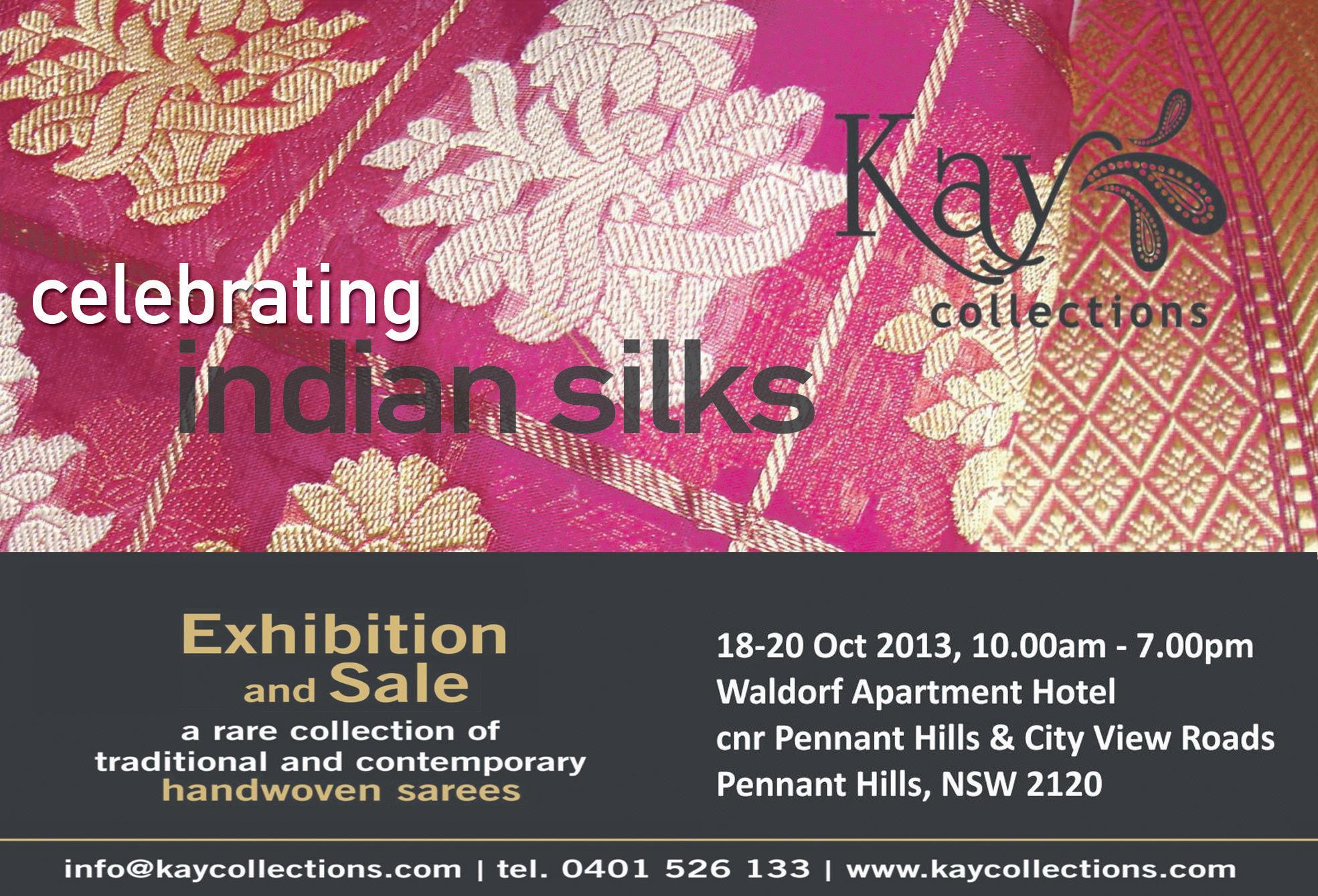

Email: contactus@completemigrationservices.com.au
(We Speak English, Hindi, Marathi, Urdu, Telugu) For quick visa assessment fill the online visa assessment form on www.completemigrationservices.com.au
We help you achieve a better life and pursue your dreams
loving mother (Suparna Mallick) and an anxious father (Carlos Sivalingam). The major influence in Swamiji’s life was undoubtedly Shri Ramakrishna Paramahamsa (Robert Rhode). This profound influence was life-changing for Swami Vivekananda, who in turn touched many lives.
One such life was of Margaret E Noble aka Sister Nivedita (Dana Dajani), who came to Kolkata from London to set up a school for girls.
Julia Kennedy-Scott, playing Kate Sanborn, who takes the Swami under her wing, helping him to get to the Parliament of Religions in Chicago, says that his message was not about converting people but uniting them, a message so timely in today’s world.

Sisters and brothers of America…”



A crowd of 7,000 odd greeted these opening lines by Swami Vivekananda with a standing ovation at the Art Institute of Chicago on September 11, 1893; and so did a crowd on September 17, 2013 at the Sydney Opera House. The first venue was the occasion for the World Parliament of Religion held in Chicago; the second was the play, Oneness – Voice Without Form staged at the Playhouse Auditorium at the Sydney Opera House in celebration of the 150th birth anniversary of Swami Vivekananda.
The play was part of a wider celebration sponsored by the Sarada Vedanta Society of Sydney. Adjectives fail to describe the Swami completely, and it is hard for a commoner to fathom his aweinspiring life experiences. So it was a mammoth task for the creators of Oneness to do justice to the influential teachings and eventful life of Swami Vivekananda. But they succeeded!
The idea for the play germinated



in 2011 when Madhuparna Sen made a solemn promise to devote herself to the staging of a play on Swami Vivekananda on a grand scale. Considering the play was staged at the Sydney Opera House, it could not have been grander. From the days of its initial conception, Swami Atmeshananda and Pravrajika Gayatriprana of the Sydney Vedanta Centre provided major support and guidance to the project.


As the crowd poured into the auditorium, the actors sat around an almost statue-like meditative Swami Vivekananda, chanting hymns. The lighting, neither bright nor dull, truly set the ambience for the spectacle that was to follow. The story was played out chronologically starting with a young restless Naren (Bali Padda) in search of God and Truth, followed by the wiser Swami Vivekananda (Saheb Chatterjee).
The play captured the essence of Swamiji’s character and highlighted some of the well-known key experiences and events in his life. Anecdotes of Naren’s early days were narrated in different scenes by an understanding and
It was as if the lead actor, Calcutta-based Saheb Chatterjee, was born to play Swami Vivekananda. He personified the humility, mysticism and sheer goodness of Swamiji with his outstanding and effortless performance. All the other actors performed well and it would be hard to pick one without mentioning the other. Twelve actors were selected from over 200 who auditioned for the roles, and came from different cultures.
Dana Dajani is a Palestinian actor based in Dubai, Bali and Suparna are Indian Australians based in Sydney, Robert has a South African background, and Carlos is Sri Lankan. Isaro Kayitesi, on the other hand, who plays Maa Sharada is of Rwandan-Anglo-Australian descent. “‘We all are one’ is the basic premise of the play, and this is visually represented for the audience as well, with the diverse cast,” Maa says.
Many of the actors had never heard of Swami Vivekananda before, but were attracted to the powerful story and the opportunity to be part of a professional production that was to be staged at the iconic Opera House.
An interesting piece of casting was Tade Adepoyibias as Maa Kaali, as she is of Nigerian descent. John Gomez Goodway, of Filipino Australian background played the Swami’s earliest disciple Sadananda, and said he felt uplifted and empowered to work in a play about Swami Vivekananda who had such a life-force to him.
Bali, a Sydney-based actor, worked in London for many years, as the opportunities for non-Anglo Saxon actors here has been limited in the past. This has been slowly changing and he said he was delighted to be part of this production which has a diverse cast, something rarely seen in Australian theatre. And the synergy between all was a strong point of this play.
Music and movement brought a different flavour to this wellknown story. The creativity of the crew behind the scenes was equally brilliant. The use of space and lighting on the stage was imaginative and effective. The original music was composed and played live by Kim Cunio and Heather Lee. Design and codirection was by recent NIDA graduates, Tobhiyah Feller and Felicity Nicol, and the movement consultant was Adelina Larsson. The writer was Alex Broun, who has extensive experience working with some of India’s top theatre artists while establishing Short + Sweet Theatre Festivals in Delhi, Bangalore, Chennai and Mumbai. The play was jointly directed by Felicity Nicol and Alex Broun. The theatre was almost packed to capacity. Although the crowd was from various nationalities, they appreciated the performance wholeheartedly. A moment of pure joy for many in the performance was when Saheb Chatterjee brilliantly sang a popular Bengali devotional song, Shyama ma ki amar kalo (Is Kali, my mother, really black?). His mellifluous voice reverberated in the auditorium and for a moment it was as if Swami Vivekananda had returned again after a hundred and fifty years.
From the days of its initial conception, Swami Atmeshananda and Pravrajika
Gayatriprana of the Sydney Vedanta Centre provided major support and guidance to the project
Music and movement brought a different flavour to this wellknown story. The creativity of the crew behind the scenes was equally brilliant. Use of space and lights on the stage was imaginative and effective
The life and experiences of this renowned personality come alive in a perfectly performed play, reports
UTTAM MUKHERJEE and JYOTI SHANKARPhoto: Salil Shrotriya Photo: Salil Shrotriya




September 22 was a special day for students of the Sydney Sanskrit School (SSS) as they gathered together with family, friends, instructors and volunteers to enjoy a valedictory ceremony marking the conclusion of the School’s three-day camp. 40 children aged from 5 to 16 attended the ‘Sanskrit for Fun’ camp, which indeed proved to be an enjoyable experience, as the children experienced a varied and well-presented agenda from Sanskrit recitation sessions to yoga, singing, arts and craft, and special break-away groups on communication for the older children. An Aboriginal couple who were invited to present their views on sustainability and the environment, among other programs, were very well received by the eager attendees through the duration of the camp.

The event began with a prayer, followed by Dr Meenakshi Srinivasan, Director of the Sanskrit School who took to the


dais to thank all for attending. She then proceeded to launch Time to Reflect, a book of short essays by Dr Saroja Srinivasan, an established clinical psychologist and well-respected member of the Indian community here in Australia. Dr Meenakshi read out a couplet that she had composed specifically for the book, and then invited Raghavan Srinivasan, Dr Saroja’s husband to launch the book. He read a few lines from the author’s note on the concept of the book. He then presented the first copy to Dr Meenakshi and Dr Lakshmi Sathyanarayana, President of the School of Vedic Sciences. Dr Saroja read a couple of poems from the book which were well received by the audience.
“By no means is this collection of essays meant as a treatise on life, just some thoughts and reflections on various topics,” stated Dr Saroja in the author’s note. “Over the years, I have had the good fortune to hear from many wise people, read some wonderful books and hopefully synthesize it all into a philosophy
for living”. This is a philosophy heartily endorsed by her in word and deed, as attested by the Indian community which is often a recipient of her kindness and generosity. The concept of consolidating Dr Saroja’s thoughts into a book developed into a reality following almost three years of writing a regular column in Indian Link, which was well received by the community. It is these gleanings from a reflective life that have been collated into the book, experiences that have made an impression on Dr Saroja through her personal life and career. Published under the auspices of the School of Vedic Sciences Inc., proceeds from the sale of 20 books donated by the author will be presented to the organisation. Several people attending the event avidly enquired about the book; unfortunately limited copies were available on the day, but more copies will be available soon.
Following the book launch, the event continued with songs
by volunteers, and the highlight of the evening, a debate between children and their parents on the enlightening topic of ‘It’s okay to be cool!’ This concluding event was conducted in an admirable spirit of camaraderie and proved to be quite an eye-opener for parents and their children as
concepts of what constitutes as ‘cool’ were diverse and highly entertaining.




The event concluded with afternoon tea and thanks to all the attendees, volunteers, participants, facilitators and parents who joined together to make the valedictory ceremony a grand success.
SBX BUSINESS BROKERS are one of the largest Business Brokers in Australia servicing Sydney, Melbourne, Brisbane and the Gold Coast. With over 28 years of experience, you can be assured that SBX Business Brokers can assist you in either selling or buying a business, Simply register online. Below is a list several businesses which are currently for sale. To find out more about these businesses or check out over 1000 other businesses we have for sale please log on to WWW.SBX.COM.AU or contact me CK on ck@sbx.com.au
/0432330910
Eastern Suburbs, T/o $16,000, Nets $1990, Asking $100,000- M1633
North Sydney, T/o 23,000, Nets $8160, Asking $1.1 MIL – M1634
Bankstown area, Franchise, T/o $100,000, Nets $10,000, Asking $990,000-U1205
Parramatta area, T/o $25,000, Nets $4022, Asking $350,000 -M1609
Inner west Convenience store, T/o $10,500, Nets $1857, Asking $84,500 – GT1099
Carlingford area, Convenience Store T/o $8,800, Nets $2346, Asking $249,000 – GT1113

North shore, Post office + Newsagency, T/o $35,100 , Nets $4,700, Asking
$580,000 –SM1336
North Sydney area, Post Office + Newsagency ,$42,550, Nets
$4300, Asking $650,000-M1457
Parramatta area, News agency, T/o $57,600, Nets $3899, Asking
$550,000 –SC1009
Innerwest, Newsagency, T/o
$58,888, Nets $4100, Asking
$395,00 –SM1287


Eastern Suburbs, Franchise, T/o $46,000, Nets $3,600 , Asking $329,000- T2754
Wollongong area, Franchise, T/o $75,500, NETS $2219, Asking $160,000 –GT1067 Wollongong area, Franchise, T/o$127,000, Nets $5560, Asking $499,000 –SR1047
Central Coast, Franchise, T/o $26,178, Nets $3000, Asking $379,000 –F2627
Inner west, Indian, T/o $8200, Nets $2230, Asking $159,000 –SC1004
City area, Indian, T/0 $20,000, Nets $3500, Asking $390,000 – SD1061 St Ives area, Café, T/o12,000, Nets $3000, Asking $150,000- M1585
North Ryde, Cafe, T/o 35,000, NETS $3,000, Asking $390,000 –T2622 Chatswood area, Franchise Cafe, T/o 20,000, Nets $2700 – FL1155
Canterbury area, Fast food franchise, T/o $17,000, Nets $2500 , Asking $255,000-W1405
The valedictory ceremony for students was enlivened through a book launch and an entertaining exchange of ideas, reports SHERYL DIXIT
In a tentative opening of doors, Prime Minister Manmohan Singh and his Pakistani counterpart, Nawaz Sharif held talks in New York recently to improve their relations. But India made it clear that peace along the LoC was a must for a full dialogue and bringing masterminds of 2008 Mumbai terror attack was vital.
Addressing media after the ice-breaking “useful and friendly” talks in New York recently on the sidelines of the UN general assembly, Indian National Security Advisor Shivshankar Menon said Manmohan Singh told Sharif that it was vital to bring to book those in Pakistan who masterminded the Mumbai terror attack that killed 166 people including many foreigners.
“Both sides wish to see a better IndiaPakistan relationship. Both sides want a much better relationship,” Menon told media.
“In order to get there, we need to address today the issues we face,” he added, which he said included restoring “peace and tranquillity” along the LoC and addressing issues related to terrorism.
“It is very important to address the terrorism issue,” Menon underlined, making it clear that while there was no proof of India interfering in the internal affairs of Pakistan, the reverse was not true.
At a separate briefing for the media, Pakistan Foreign Secretary Jalil Abbas Jilani termed the talks “positive and constructive,” but took the line that a “peaceful sustained and uninterrupted dialogue” was the way to resolve issues between them.
“There is no alternative to a peaceful sustained and uninterrupted dialogue. We need to have an interaction on a regular basis to address all our outstanding issues,” he said.
The two prime ministers tasked the Director Generals of Military Operations (DGMOs) of both countries to come up with “effective measures” to restore the 2003 ceasefire on the Jammu and Kashmir border, the Indian national security advisor told media.
“The decision was for DGMOs to come up with real plans to restore the ceasefire”.
Menon said Sharif raised issues of concern to Pakistan including the disputed
Siachen glacier and Sir Creek.
“Our overall impression was that the meeting was useful, it provided an opportunity to discuss issues that are troubling the relationship,” he added.
Sharif invited the Indian Prime Minister to visit Pakistan, and Manmohan Singh, who was born in what is now the Pakistani Punjab, reciprocated. No dates have been set for their visits.
Menon acknowledged that while the two leaders desire a better bilateral relationship, they were “also conscious of the difficulties standing in the way”.
On the issue of terrorism, saying that it affected them both Jilani made no promises and instead harped on Kashmir and spoke of “external interference” without naming India.
“Terrorism was discussed. We are aware of your concerns on terrorism, and I think our concerns are also known to the Indian side,” he said in response to a question from Indian media.
Asked about Manmohan Singh’s description of Pakistan as the “epicentre of terrorism” Jilani said, “It was not raised during the meeting. Terrorism was discussed but not in the context that you are talking about”.
“Prime Minister Sharif also emphasised on external interference in Balochistan and other parts of Pakistan,” Jilani said.
Describing Kashmir as a “very important issue” that needs to be resolved, Jilani said, “We witnessed an equal willingness on the part of the two leaderships to discuss things in an amicable manner”.
Responding to questions on Mumbai attack mastermind Hafeez Saeed and his organisation Jamaat-ud-Dawa (JuD), Jilani parried saying there is “willingness and commitment” on the part of both sides to discuss the issue of terrorism.
The schools and other educational institutions being run by JuD have now been taken over by provincial government of Pakistan at the direction of Islamabad in compliance with the UN Security Council resolution in this regard.
Jilani also claimed that the monitoring team of the UN which had recently visited the country in its report had found nothing about Pakistan violating the UN Security Council resolution in this regard.
Cardiovascular diseases (CVDs), including heart disease and stroke, cause 17.3 million deaths each year worldwide, and by 2030 it is expected that 23 million people will die from CVDs annually, a report released recently in New Delhi said.

September 29 was observed as World Heart Day. Every year since 2000, September 29 has been observed by the World Heart Federation as World Heart Day to spread awareness about the rising instance of heart disease.
“Cardiovascular diseases (CVDs), including heart disease and stroke, take lives prematurely,” said Rishi Sethi, associate professor, Department of Cardiology, King George’s Medical University, Lucknow. “In fact, they cause 17.3 million deaths each year and the numbers are rising. By 2030, it is expected that 23 million people will die from CVDs annually”.
The intervention cardiology data compiled by Rishi Sethi revealed that over 4,500 lifesaving angioplasty procedures and almost 2,000 lifesaving pacemaker implantations have been performed in 2011-2012 in the state of Uttar Pradesh. The number of these procedures has increased by almost 30 percent over the last year, he said.
“Children are vulnerable too, the risk for CVDs can begin before birth, during foetal development, and increase further during childhood with exposure to unhealthy diet, lack of exercise and smoking,” the doctor said.
The doctor also underlined how simple lifestyle changes like giving up tobacco could make a big difference to cardiovascular health.
“The tobacco industry interference in public health policy has been recognised as the biggest obstacle in enforcing tobacco control laws. Strengthening tobacco control is one of the evidence-based ways to reduce CVDs,” said Ehsaan Latif, director, Tobacco Control, at the International Union against Tuberculosis and Lung Disease.
It is an international voluntary scientific organisation working in low and middle income countries to fight HIV/AIDS, TB, lung disease, tobacco-related morbidity and non-communicable diseases.
Canada has announced the coming into force of a Nuclear Cooperation Agreement with India.
This was announced by Canada’s Minister of Natural Resources Joe Oliver and Lynne Yelich, minister of state (Foreign Affairs and Consular) in the Canadian capital.
“This coming into force results from Canada’s vigorous efforts to reach new markets for energy exports, creating opportunities for Canadian business. The Canadian nuclear industry currently supports 30,000 direct jobs across our country,” said a statement issued by the Canadian High Commission in New Delhi recently.
Oliver said, “This milestone represents a significant step in diversifying markets for our energy exports, thereby creating jobs and solidifying Canada’s long-term prosperity”.
“The agreement with India will permit Canadian companies to reach an important new market for Canadian uranium, nuclear technology, services and equipment,” he said.
Oliver had met External Affairs Minister Salman Khurshid September 23 in Ottawa. He visited India in October 2012 to promote Canadian exports to India, the fourth-largest energy consumer in the world. India is expected to more than triple its electricity supply within the next 25 years, the statement said.
Oliver had earlier announced that the Appropriate Arrangement Agreement pursuant to the Canada-India Nuclear Cooperation Agreement had been signed by both countries in Saskatoon April 8, 2013.
“I am very pleased that this crucial agreement is now in force,” said Yelich. “It is important for the province of Saskatchewan, one of the world’s largest producers of uranium, and can only solidify Canada’s already strong relationship with India”.
“The Nuclear Cooperation Agreement and the supporting Appropriate Arrangement will allow Canadian companies to export nuclear items for peaceful uses, in accordance with Canada’s nuclear nonproliferation policy. The Canadian Nuclear Safety Commission, Canada’s independent nuclear regulator, will be responsible for implementation, ensuring that Canadian exports only go to facilities in India under International Atomic Energy Agency safeguards,” the statement said.
“With the coming into force of this Nuclear Cooperation Agreement, the Canadian government reaffirms its commitment to support and grow Canada’s nuclear industry, which generates about $5 billion in electricity annually and approximately $1 billion a year in uranium exports,” the statement said.
India and Canada had signed a civil nuclear cooperation agreement in 2010.
With his hand on the Gita and watched by family friend Gursharan Kaur, Indian Prime Minister Manmohan Singh’s wife, Chandigarh-born legal luminary Sri Srinivasan made history as he became the first Indian American to be sworn in as a judge of what is often called the second most powerful court in the US.
Srinivasan, 46, was sworn in an overflowing court room by retired Supreme Court judge Sandra Day O’Connor, in the presence of legal luminaries, friends and families as his mother Saroja Srinivasan held the Gita, the
sacred book of Hinduism, before him.
Gursharan Kaur literally rushed from the airport with just a short halt at the hotel to watch the investiture of Srinivasan on the bench of the US Courts of Appeal for the District of Columbia Circuit.
O’Connor, for whom Srinivasan once clerked, called him “fair, faultless and fabulous”.
Confirmed by the US Senate in May by a 97 to 0 vote, Srinivasan was earlier principal deputy solicitor general of the US to which job he succeeded another Indian American, Neal Kumar Katyal, in August last year.
Srinivasan came to the US with his parents in the 1970s at the age of four. His family settled in Lawrence, Kansas, where his father was a mathematics professor at the University of Kansas, and his mother taught at the Kansas City Art Institute.
He received his BA with honours and distinction in 1989 from Stanford University and his JD with distinction in 1995 from Stanford Law School, where he was elected to Order of the Coif and served as an editor of the Stanford Law Review.
Green activists recently walked along the Yamuna to the Taj Corridor to highlight the plight of the river burdened by human waste and industrial pollutants.
The ‘Walk for Yamuna’ was undertaken on World Rivers Day, to draw attention to rivers facing severe and increasing threats associated with climate change, pollution and industrial development.
The Yamuna in Agra is now seen posing a major threat to the historical monuments along its banks including the 17th century Taj Mahal, whose foundation needs constant moisture.
“But in the past two decades, all kinds of pollutants and toxics are freely flowing into the river,” said an organiser of the walk, Shravan Kumar Singh. These could corrode the structure below the main platform of the Taj, he said.
Jugal Kishore Shrotriya, a temple priest and a young green activist, said that the Yamuna, for all practical purposes, was dead in Agra.
“Only garbage, carcasses and sewer flow,” he said. “The aquatic life has been decimated. So many plans and schemes to save the river have gone down the drain”.
Activists said the free flow of the river has been obstructed by a series of barrages upstream that hold up all the water. What reaches Agra is just waste and sewage.
“The Yamuna Action Plans have made no discernible improvements in water quality. The flow is inadequate. The sewage treatment plants either do not work or are short of resources,” said Surendra Sharma of Heritage Society.
Sex selection of a baby at the pre-conception stage is on the rise, and now a Rs.15 crore business, a lawyer said in New Delhi recently, while addressing a symposium on the challenges in the implementation of the law on the issue.
“The sex determination of a foetus preconception in the laboratory is on the rise in our country, and has emerged as a lucrative Rs.15 crore business,” said advocate Varsha Deshpande, speaking at a symposium in the national capital that deliberated on the implementation of the Pre-Conception and
Pre-Natal Diagonistic Technique Act (PC PNDT), 1994.
“Sex determination before the preconception stage through selection of chromosomes is not strictly prohibited under the PC PNDT Act,” Deshpande explained, adding that procedures exist by which parents opting for in-vitro fertilization procedures might select the sex of the unborn baby without breaking the law of 1994.
The PC PNDT Act prohibits sex selection, before or after conception and provides for regulation of prenatal diagnostic techniques for the purpose of detecting disorders and the prevention of their misuse for sex determination, leading to female foeticide.
Asha Menon, member-secretary, National Legal Services Authority (NALSA) said, “It is important to check now, as the in-vitro fertilisation unit has resulted in the highest number of male births”.
As per the 2011 census, Delhi recorded a low child sex ratio of 866 girls to 1,000 boys.

The act of 1994 was introduced after ultrasound techniques began to be used in the 1990s to determine the sex of the foetus. The number of female foeticides rose as a result of the technique, and the sex ratio (number of girls for every 1,000 boys) showed sharp decline.
“The situation is becoming extremely serious, with some sections of the media reporting a child sex ratio of 789 girls per 1,000 boys in the last quarter. Hence there is an urgent need for a consolidated effort from the law enforcement agencies and civil society organisations to address this issue at the earliest,” Ranjana Kumari, director, Centre for Social Research, said.
Spiritualist and pioneer of the Vipassana meditation in India, S.N. Goenka, 90, died on the night of September 29 at his residence in Mumbai due to old age, said aide Gautam Gaikwad in Mumbai.
He is survived by his wife Mata Elaichidevi and six sons.
The funeral was held in Jogeshwari electric crematorium.
Goenka started teaching Vipassana
meditation in 1969 and followed it up with a meditation centre in Igatpuri, near Nashik, in 1976.
Last year, Goenka was conferred the Padma Bhushan, India’s third highest civilian award.
Born and raised in Burma, Goenka was a successful businessman when he came in contact with the late Sayagyi U Ba Khin, who taught him the Vipassana techniques.
After 14 years training under Sayagyi, Goenka decided to settle in India and started teaching Vipassana meditation in 1969.
He established the Vipassana International Academy, a meditation centre in Igatpuri in 1976.
Later, 172 more such centres blossomed worldwide, including 75 in India.
In 1982, he became a vipassanacharya and started training teachers worldwide and established the Vipassana Research Institute in Igatpuri in 1985.
Goenka’s technique represented a tradition that can be traced back to Lord Gautam Buddha who taught ‘Dhamma’ as the nonsectarian way to liberation.
Goenka’s approach was also totally non-sectarian and found universal appeal, including among jail inmates in India and US.
In 2000, Goenka addressed the Millennium World Peace Summit at the UN headquarters in New York.
Following his passion, he laid the foundation of the Global Vipassana Pagoda at Gorai Beach, in north-west Mumbai.
Standing at 325 feet (or the height of a 30-storeyed building), it encompasses the world’s largest pillar-less stone dome, twice as big as the Basilica of St. Peter at the Vatican City.
In the centre is a circular meditation hall, 280 feet in diameter with a seating capacity of 8,000, and relics of Buddha are kept in the pagoda.
Goenka believed that the monument would bridge different communities, sects, races and countries to make the world a more harmonious and peaceful place.
Rewarded for his recent good form, all-
rounder Yuvraj Singh was recently recalled in the Indian team for the first three One-day Internationals of a seven-match series and a one-off Twenty20 against the touring Australia.
The selection committee of the Board of Control for Cricket in India (BCCI) announced the 15-man squad for the series in Chennai, making four changes in the squad that won the Champions Trophy in June.
Yuvraj, Ambati Rayudu, Mohammed Shami and Jaydev Unadkat have been picked in place of Murali Vijay, Dinesh Karthik, Irfan Pathan and Umesh Yadav.
Other seniors like Virender Sehwag, Gautam Gambhir and Harbhajan Singh will have to wait for their return to the national fold.
Yuvraj comes to the side after scores of 84, 52, 61, 40 and 123 in the series against West Indies A and Challenger Trophy. His last international match was an ODI against England in Dharamsala in January.
Fast bowlers Shami and Unadkat have been rewarded for their impressive show in the five-match series in Zimbabwe.
The axe for speedster Yadav is surprising though he proved expensive in the Challenger Trophy. Wicket-keeper Karthik was overlooked against Rayudu, who averaged more than 50 runs in Zimbabwe. Opener Vijay could not retain his place while Irfan Pathan is injured.
Off-spinner Ravichandran Ashwin replaces Parvez Rasool, who misses out after the Zimbabwe stint alongside Cheteshwar Pujara, Mohit Kumar and Ajinkya Rahane.
India will play a T20 and seven ODIs against Australia but selectors decided to pick the squad only for the initial three games.
The T20 will be played in Rajkot, October 10. The first three ODIs will be hosted in Pune (October 13), Jaipur (October 16), and Mohali (October 19).
India squad: Mahendra Singh Dhoni (captain), Shikhar Dhawan, Rohit Sharma, Virat Kohli, Yuvraj Singh, Suresh Raina, Ravindra Jadeja, Ravichandran Ashwin, Bhuvneshwar Kumar, Ishant Sharma, Vinay Kumar, Amit Mishra, Ambati Rayudu, Mohammed Shami, Jaydev Unadkat.
IANS


It was a heart-wrenching moment for his family and fans to watch Canberra’s favourite contestant Hrishikesh Desai, aka Rishi, come so close to making it to the grand finale of MasterChef Australia 2013. However, one fatal mistake in the elimination challenge sadly sent him home. But for this 35-yearold, who cooks from the heart, it’s not all about winning. Rishi has a bigger plan in mind. He wants to take Indian cooking to a whole new level in Australia. And he is grateful to MasterChef for giving him a platform to showcase his talent and bring him step closer to achieving his dream of opening a modern Indian restaurant

to work towards my dream”.
Rishi was focused and on the right track from his first team challenge on the show. He surprised everyone by his accuracy and speed in the kitchen. People’s expectations started to rise with every perfect dish he presented, and unlike his fellow contestants, he never lost his composure at the MasterChef headquarters.
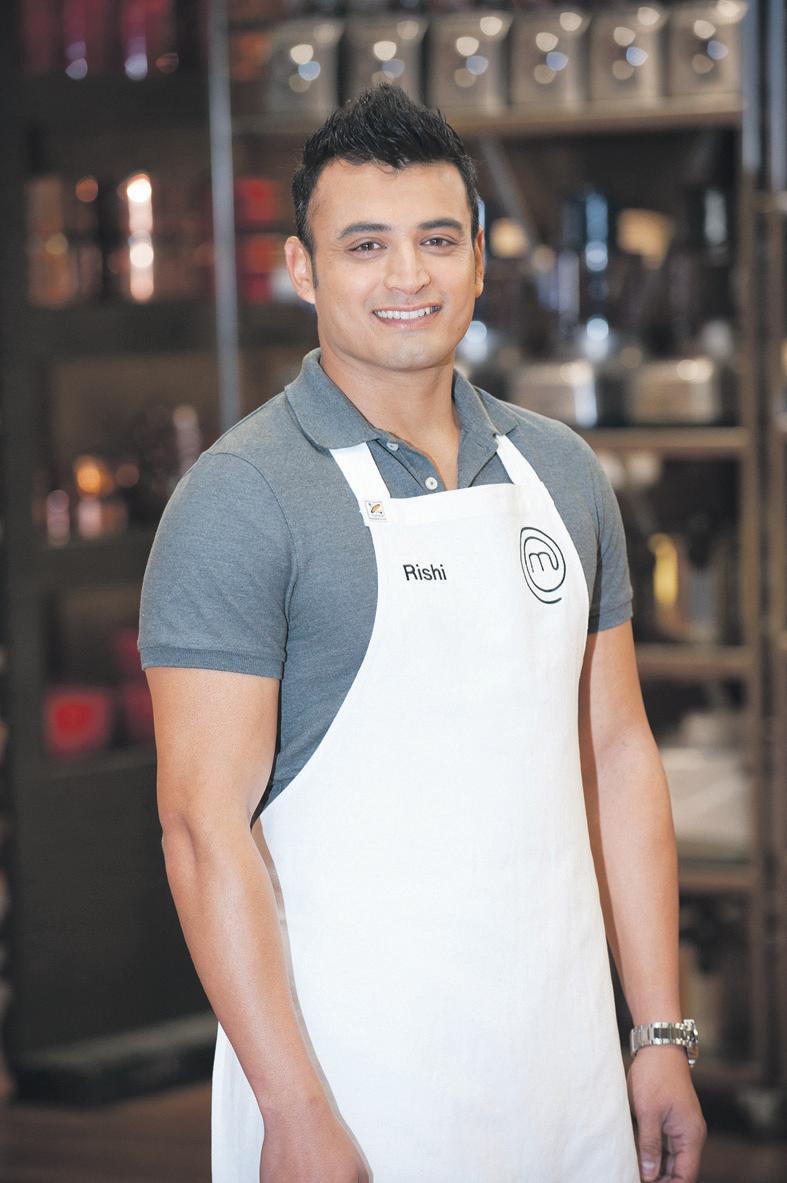

“I am the kind of person who thrives under pressure,” said Rishi. “In a high pressure situation, the worst thing to do is to lose your composure. It is better to step back for a few minutes, assess the situation and come up with a solution, rather than panic, lose 30 minutes of valuable time and have no solution at hand. It is common-sense for me, and this is what kept me focused. What kept me going was my end goal, which
to walk away from the show on his last day. Recalling where things went wrong on the day, he said,
“I was disappointed in myself for not making it to the finals. I knew I could have done better than I did that fateful day. On the day of my elimination I had 30 minutes to cook the mussels dish. So I had a process and a checklist in my mind… this is what happens when you work as a machine and not as a human,” he said with a chuckle.

“As I did not have a lot of time, I made a list of things I needed to get done – one, cook mussels; two, make sauce; and three, make flat bread. In my mind I ran this program and executed it with fantastic accuracy, except my order of steps was wrong. So I cooked the mussels first which ended up overcooking by the end of 30 minutes,” lamented Rishi.
One of the most cherished moments for this talented chef on the show was the opportunity to cook with his role model and someone from whom he draws his food inspiration. “My most memorable moment was working with my food hero, Heston Blumenthal,” he said. “I cooked in the kitchen with him for four days and was privileged to cook the Heston trifle and Heston’s edible garden. The immunity pin challenge cook off against Heston where I wanted to reproduce something that I had learned watching him, was hard to replicate. Unfortunately the ‘Snow Man’ did not work out,” said Desai. Another challenge very close to his heart was the ‘Dreams’ week. “We had to cook for our families and in the elimination, we had to
serve in our restaurant,” he said. “The challenge gave a boost to my ability to cook modern Indian food. My favourite masterclass was in Perth, with the backdrop of the Indian Ocean and I made impersonations of Gary, Matt and George,” he chuckled.

Experimenting with different cuisines is something Rishi loves to do in his spare time at home. Cooking is therapeutic to him.
“I love to cook different cuisines at home,” he said. “We love to try Chinese, South East Asian, Indian, Italian, Mexican and North African flavours. I specially love Chinese food in general, but Sichuan province food is my favourite”.
Rishi also thoroughly relishes his traditional Kolhapuri food. His favourite place to eat in India goes back to his roots. “I always would go back to a sugarcane farm and have traditional Kolhapuri food of bhakri, mutton sukka, tambda rassa, pandhra rassa, and for dessert, hot fresh jaggery and bhakri. There is nothing like it in the world,” he said with relish. Rishi stays well connected to his family back home, visiting every couple of years.
Rishi was born and bred in






Known for his precision and nicknamed the ‘machine’ by his fellow contestants, Rishi received a lot of praise from the judges as well

“As far as I am concerned Indian food needs to move on from curry in a bowl to something contemporary. Our food has tremendous potential in terms of modernising. I live by Heston’s philosophy: food should consumed using all of your senses and not just taste. For example, I want to present a dish which tastes exactly like palak paneer completely different,” explained Rishi.
There is good news for his fans as well, who can keep an eye out for his cookbook and popup restaurant in the near future. “I plan to write a cookbook on modern Indian food and eventually open a restaurant; but before that I want to test the waters first. I am working towards opening a pop-up restaurant in Canberra and will see how things go,” he revealed.
Masters at Rochester Institute of Technology, USA. He migrated to Australia in 2008, to work as a patents examiner at Intellectual Property (IP) Australia (Australian Patent Office) and is now assistant director of an examination division.
Rishi’s passion for cooking started quite young. “As far as I remember and relying on my mum’s accounts, I have always
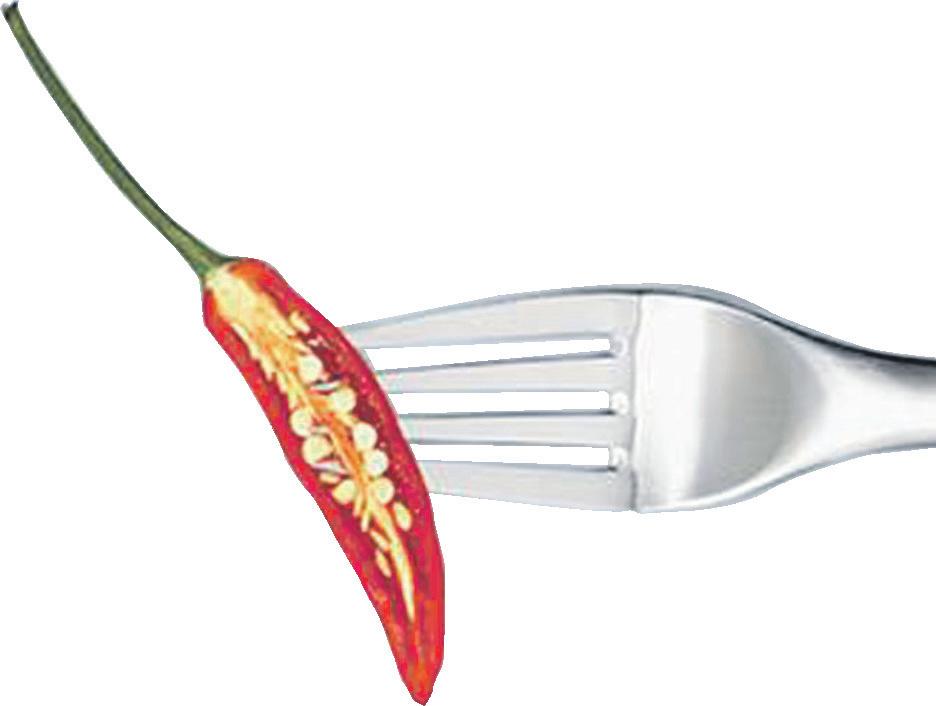




first thing I ever cooked was 2 minute Maggie noodles when I was five, and since then I have never looked back. When I am in the kitchen I am at peace,” said Rishi.
He has always had a strong influence of women in his life especially after losing his father at just 15. His mother raised him and inspired him to cook. “The inspiration and knowledge of
stated.





Rishi’s wife Mitra and son Sharang are probably his biggest fans, who have been the driving force behind him throughout his MasterChef journey.



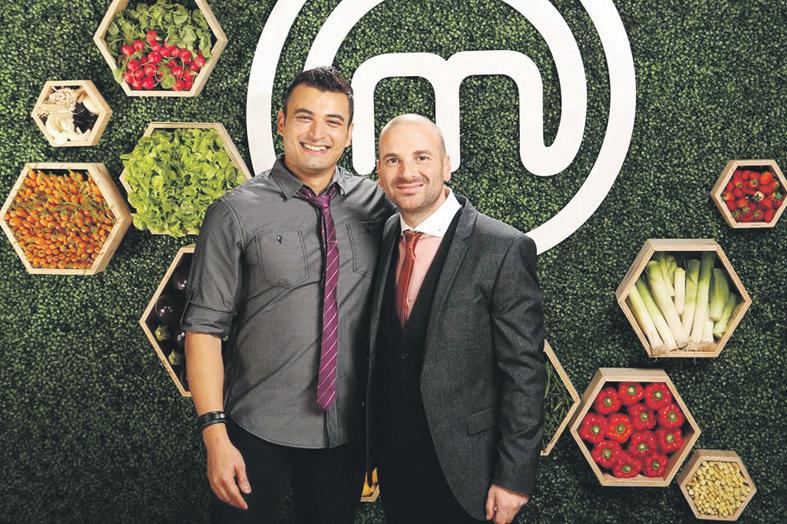


“My wife of 13 years is my best critic and she says if she hadn’t let me take charge of the kitchen at home, I would not have ended up on MasterChef Jokes apart, without my family’s support, I would not
have made it this far,” he said. A doting father, it was tough on Rishi to be away from his six and half year old son while shooting for MasterChef. “It was extremely difficult staying away from my family for the five months. I could speak to them on and off, but my son missed me a lot and I missed five months of his childhood. After I got mother had from India to greet me, as well as friends came home to celebrate my success. So it was the best homecoming for me,” said Rishi. However, Rishi strongly feels Indian food has a lot more to offer than it currently does in Australia, and needs to break the stereotypical image of curry in a
Rishi is a complete family man with a humour. Despite all the fame and recognition from Masterchef and thousands of fans on social media since the show, he remains very humble and grounded. “Well, I wouldn’t say life has changed, but I am certainly a changed person
The blocking ability of the Australian Senate was made clear in 1975 when the then Prime Minister Gough Whitlam was unable to get bills passed by that chamber. That gave the then GovernorGeneral Sir John Kerr, the excuse to have him dismissed in an unprecedented fashion. Simultaneously, Sir John Kerr appointed Malcolm Fraser as the Prime Minister. The wounds that the Labor Party suffered at the time are still raw.
Today, the Australian Senate is again seen as a stumbling block in the legislative reform process by the new Liberal government headed by Tony Abbott.
of Commons is taken for granted; the Prime Minister of Britain by tradition comes from the House of Commons. However, the House of Lords, which is considered as a house of review, can delay and modify bills sent from the House of Commons. But it cannot reject money supply bills.
Australia did not choose the British model of the House of Lords as the country is supposedly egalitarian in nature, and has no aristocracy
To illustrate the need for upper houses let us take a hypothetical case. Consider if there are only Parliaments based on House of Representative members. Then imagine if there is one group of people which form a majority community say fifty-five per cent, it would be possible for that group to get all the seats in Parliament and no seats for any other group, ethnic or otherwise. This is what happened in Nazi Germany where all minority groups were tyrannised. So, in some countries there could arise the situation that minorities never get representation in a Parliament.
Clive Palmer, whose Palmer United Party is expected to gain the balance of power in the Senate, has said that he would block the legislative process unless the Government agrees to reform the manner in which elections are conducted.
There are two countries where Upper Houses or Senates are currently causing problems for elected governments: Australia and the USA. This similarity should cause no surprise as the Australian Senate was based on the American model. Australia did not choose the British model of the House of Lords as the country is supposedly egalitarian in nature, and has no aristocracy.
In Britain, the names of the two chambers reveal their nature: the House of Lords is a relic from the past when Lords (predominantly male) ran the country. As a result, there still exist some memberships in that chamber which could be considered as archaic; this includes the 26 Lords Spiritual who belong to the hierarchy of the Protestant Anglican Church.
Then there are Lords Temporal which includes hereditary Lords and others who have been given life peerages and have been nominated as barons and baronesses. The current Speaker in the British House of Lords is Baroness Frances Gertrude Claire D’Souza, a scientist who was nominated to the House. She is of Indian origin. Another well-known Indianorigin Baron is Lord Bhaji.
Let us take an example of a minority group seeking to find a voice in the Senate. In the very unlikely event that Indians in an Australian state decide to field a candidate, they would first have to think of a state which has a substantial number of Indians, such as New South Wales. If almost all Indians in that State do vote, then such a possibility exists.


In a democracy there will always be groups of citizens who form minorities. Minorities can be groups of people who are members of ethnicities, workers, the poor, the disadvantaged, the political right and the political left. Several such groups put up candidates for election to the new senate and some, to the surprise of many, actually win seats.
The current focus on the Senate is how its elections are conducted. This has been promoted quite forcibly by Clive Palmer of Palmers United Party who will have the balance in that house. Some of his demands should be practically feasible, such as marking ballot papers with ink and not pencil, as is currently done. The next is that booths should be manned by a wide selection of people and not by just military officers as Palmer says happened in Fairfax where he is standing for the House of Representatives.

Some of (Palmer’s) demands should be practically feasible, such as marking ballot papers with ink and not pencil, as is currently don
The House of Commons is, in contrast, an elected body made up of commoners. In Britain there have been, over the last few centuries, battles between the two houses for dominance by either one or the other house. Today the supremacy of the House
Senator Nick Xenophon suggests that voters mark ballot papers below the line so that all preferences are marked. Currently, marking above the line transfers the power of distributing preferences to the party marked above the line. Therefore the Labor and Liberal parties who got the largest number of votes have had a disproportionate number of preference distributions. They can thus distribute preferences to parties which the voter had never intended.
The above suggestions can be implemented without going to a referendum. Referenda have been notorious for their rejection by the Australian people.
A power imbalance within the Australian Senate is proving to be a stumbling block in the legislative reform process


We are specialized in:



Preparation of the Individual & small to medium sized Company Tax Return, Partnership, Trust, Superannuation Return, Payroll and BAS. Registration of ABN and Business Name; Set up of Company, Superfund, & Trust. Financial Planning, Tax Investment Property, Mortgage Loan, Audit for Real estate Trust Account, Audit-Solicitor Trust Account, Audit for self-managed superannuation, Travel Agents and all other businesses.
Council has launched Growing Liverpool 2023 and its Economic Development Strategy, two integral plans for the future direction and economic growth of Liverpool City.
I want us to be proud of our city and these plans create the road map for us to get there. To read the plans, please visit Council’s website.
Council in partnership with South West Sydney Business Enterprise Centre, the Liverpool Chamber of Commerce and South Western Sydney Institute TAFE NSW recently hosted Liverpool’s inaugural Small Business Week. I’m pleased we could support local businesses with a series of free seminars on how to plan, market and expand existing and new businesses.
Liverpool City Library is hosting the Escape from Vietnam exhibition which features photographs from the late 1970s and 80s when many Vietnamese people fled the country to escape tragic circumstances and undertook perilous journeys in search for a better life. The exhibition is a testament to the human spirit and I encourage you to attend.
Ned Mannoun, Liverpool City Mayor

without such a disclosure requirement.


 BY MOHAN DHALL
BY MOHAN DHALL
One of the most common inquiries to the Australian Tutoring Association (ATA) is what the requirements are for becoming a tutor. It is heartening that many prospective tutors are keen to know what, if any, standards apply in regards to entry into the industry.
The nature of tutoring is such that it straddles two seemingly opposing areas of human endeavour. On the one hand, it is commercial in nature, and therefore commercial rules apply. In the alternative, tutoring is about education and educational accountability. These two; the commercial and the educational, overlap in tutoring in a way that causes a unique set of issues.
Consider the issue of plagiarism, for example.
Plagiarism, in an educational sense, is defined as the passing off of another’s work as one’s own, without authorisation to do so. The educational definition focuses on the nature of the creator of the work and their relationship to that intellectual property. It seeks to ensure that the owner is rewarded for their endeavours, and that personal effort is valued. A commercial view of plagiarism, as it relates to tutoring, would look at the nature of dependency. If a tutor does the work of a student, the student becomes more dependent. In
this context, plagiarism generates income and entrenches weakness in the student. The tutor is the ‘paid help’ actually weakening, rather than strengthening the recipient. Therefore, if the issue of dependence was included in the definition of plagiarism, any problem arising from how commerce affects tutoring could be addressed effectively.
In this example, it can be seen that tutoring creates a particular set of dynamics that present problems for commercial regulators and also educational administrators. However, experience around the world has shown that regulating the private tutoring market can be fraught with difficulties. For example, an outright ban on private tutoring in Egypt failed when the black market for private tutors flourished. Similarly, a proposed ban by the Turkish government has been modified in the light of huge opposition from families and educational advocates.
How then can the growing
domestic and global market for private tutoring be best managed?

The current arrangement in Australia is a model of selfregulation. Self-regulation requires an industry to demonstrate maturity in that the industry itself is prepared to benchmark best practise and to hold practitioners accountable to such standards.
There are five important features of successful selfregulation
• The presence of a peak representative body
• The creation of a code of ethics or code of conduct by the peak body and applicable to the membership particularly and the industry more broadly. The code should also have a regime for sanctions or penalties than can be imposed on providers who breach it
• The creation of a vehicle for the settlement of disputes arising between practitioners and clients and practitioners themselves
• A form of accreditation that acts as an entry mechanism and a means by which standards can be set and improved over time
• Recognition by government of the peak body and its standards

To date, the missing piece in Australia, and one which is essential for responsible selfregulation, is that of a viable and rigorous accreditation for tutors. How embarrassing when prospective tutors are told that, “at present in Australia there is no entry criteria other than an operator abide by the relevant commercial and child protection laws”.


Self-regulation demands that each of the five features be present. In Australia four are met, but accreditation is not. So it is time to test the tutors. Disclosure is an essential element of the test. That is, a tutor should be honest and upfront about the exact and specific nature of their skills, experience and qualifications. The term qualified tutor is meaningless
It is time for Australian tutors to embrace an industry-based accreditation. Globally, only two nations have a form of accreditation for tutors: the USA and Germany. The model in the USA is cumbersome and at present a very small proportion of tutors (estimated at less than 0.5%), have become accredited. In Germany the model is based on ISO9000 and is so rigorous and expensive that it has not been embraced by the industry. Only 30 businesses out of 4,000 comply (or 0.75%).
The characteristics of relevant accreditation for Australian tutors should be that content and skills reflect local experience and match the aspirations of a best practice code. Included in such an accreditation should be compulsory national police background checks. This would overcome the present ad hoc situation of a lack of uniform national laws in regards to child protection.
With regards to knowledge, skills and abilities, teachers who tutor should be recognised for their prior knowledge and experience.
Finally, an accreditation should have both core and optional units to ensure minimum levels of qualification, as well as a capacity to specialise. Such a model allows for continuing professional development (CPD).
Tutors need to be put to the test and national standards raised. In this way, children and their families are better respected, and outcomes for tutoring are raised. The industry needs to demonstrate this responsibility and maturity.






Most of the time we try and stick to our usual regular meals and foods. And especially when we think healthy, only a few foods come to mind. But there are lots of different types of food available that are healthy which also add variety and spice to our meals. Here are some of these uncommon, but healthy kinds of food.
These are young versions of green soybeans that are picked while still attached to their branches. In Japanese they literally mean ‘beans on branches’. These young soybeans are an excellent source of plant protein, antioxidants, iron and fibre. They have a slightly sweet and nutty taste, and can be steamed or cooked in a microwave. They can then be squeezed out of the pod and used as a crunchy snack, or added to soups, stews, casseroles and stirfrys. The beans can be pureed into hummus and enjoyed as a creamy dip if you add garlic, lemon and tahini (sesame paste).

Quinoa is becoming quite popular as a health food these days, and is excellent for people on a gluten free diet. Being a high protein grain it is a very good source of protein for vegans and vegetarians, and a good substitute to white flour. It is also a good source of fibre and has a low GI, which allows long-term satiety. It also contains iron, calcium and magnesium for a healthy nervous system. Quinoa tends to have a slightly nutty flavour and firm texture. It is versatile and can be used instead of rice or added to desserts, stir-frys, puddings and patties. You can even prepare quinoa gluten free pancakes, muffin, breads and cookies. It can be used as a breakfast meal with honey, fruit and nuts, and in salads.
Bulgur wheat is a wholewheat grain that has been cracked and partially pre-cooked. It is traditionally used in Middle Eastern cuisine, and is added to tabbouli and pilafs. Bulgur is richer in nutrients and vitamins
than refined, processed wheat, which has been stripped of many beneficial ingredients. Low in fat, high in fibre and rich in minerals, bulgur wheat is a healthy dietary choice.
Natto is a traditional Japanese dish made from soybeans fermented with the bacteria Bacillus Natto, which makes them easier to digest and absorb. It has a strong smell and you need to acquire the taste of eating natto. In Japan, it is a considered an important health food and is often eaten at breakfast with rice and sometimes with mustard, soy sauce, broth, vegetables or a raw egg. Natto has the amount of protein equal to a lot of animal foods, but with fewer calories. Natto also contains vitamin K, which is needed for normal blood clotting and regulation of calcium in the body, keeping it in the bones and out of the arteries. In addition, natto provides vitamin E and vitamin B2, and contains an enzyme called nattokinase, produced during the fermentation process, which is also said to help prevent blood clots.


Wheat germ is the most vitamin and mineral-rich part of the wheat kernel. In fact, the germ is actually the embryo of the wheat plant. But this kernel, which includes the wheat germ, is removed during the refining of wholewheat grains to white flour. Because its healthy oils can go rancid quickly, removing wheat germ helps to store wheat for longer. It is packed with important B vitamins, such as folate, thiamin and vitamin B6, and the minerals zinc, magnesium and manganese. It is also a good source of Vitamin E. You can incorporate wheat germ into casseroles, muffins and pancakes, or sprinkle it over cereal or yogurt. The texture of wheat germ can add a great crunchiness and taste to these foods.
Beets are a good source of both folate and phytonutrient betalains. Betanin and vulgaxanthin are the two best-studied betalains from beets, and both have been shown to provide antioxidant, and antiinflammatory, properties. It is important to have beets raw or

just sautéed with a little lemon juice and olive oil, as they lose nutrients when cooked.

Since the last few years, seaweed has become a popular health food, from being included in sushi rolls to snacks.

Some of the most popular edible seaweeds include deep green kombu, dried black hijiki, chewy red dulse, emerald wakame, bright, leafy sea lettuce, and dark, toasted nori. Nori, which is a red seaweed that turns black and green when dried, is one of the most prevalent types for snacks. Nori is rich in proteins, fibre, Omega-3 fatty acids and Vitamin C. The wakame variety of seaweed is a good source of calcium and magnesium, and thus prevents osteoporosis. Raw seaweed is normally available at Asian supermarkets and can be cooked with a little olive oil and salt and pepper or added to salads.
Let’s break the habit of eating regular meals and snacks, and try to add these foods which might not be familiar, but are packed with health benefits and nutrition.
Some of the most popular edible seaweeds include deep green kombu, dried black hijiki, chewy red dulse, emerald wakame, bright, leafy sea lettuce, and dark, toasted nori





Compiled individual viewpoints offer an informative and reflective perspective of Indians overseas, says FREDERICK NORONHA
edited by Ajaya Kumar Sahoo (assistant professor at the Centre for the Study of Indian Diaspora, University of Hyderabad), Michiel Bass (coordinator, International Institute for Asian Studies, Amsterdam/Leiden), and Thomas Faist (professor, Transnationalization and Development, University of Bielefeld, Germany).

The label of diaspora has, in recent years, become an interesting sought after, and contested, term, Pablo S. Bose of the University of Vermont reminds us in an essay titled Kolkata, Transnationalism, and the Diasporic Imaginary. The size of the Indian diaspora is variously estimated at anywhere between 18 and 40 million people worldwide, he notes. Such a wide discrepancy in figures has much to do with how one defines membership.
“To think of Kolkata as a diasporic city requires, at first blush, considerable imagination,” writes Basu. But, he says, interviews with promoters and developers of projects suggest that between 25 and 75 per cent of ownership in condominium complexes is by overseas Indians, for instance.
abroad, a flow of “transnational economic and information resources start”. These range from occasional remittances to “the emergence of a class of full-time transnational entrepreneurs,” notes an essay by Steven Vertovec (University of Gottingen).

C.J. Fuller of the LSE and John Harriss of Simon Fraser University in Canada, in a chapter titled Globalizing Hinduism, look at “a ‘traditional’ guru and modern businessmen in Chennai”.
Another essay on “conceptualising Hinduism” by Heinz Scheifinger mentions its “incredible diversity” and the online images of Hindu deities. Another study looks at how the Jamaat-e-Islami Hind (JIH) of India and its student organisation SIMI “developed links with Islamists in Saudi Arabia, the United States, and Iran”.
Irfan Ahmad (Monash University) says the JIH had to devise new methods of working in Saudi Arabia and Kuwait, as royal regimes there do not permit political congregations.
Early on in the hard-bound volume, its three editors raise issues of “theoretical developments and practical implications” of Indian transnationalism
Like the parable of the Elephant of Hindoosthan, the Indian diaspora is indeed a strange animal; difficult to map, complex to comprehend and wide in its scale. “Migrants,” says this book, “no longer simply cross borders to live elsewhere but regularly turn this ‘crossing borders’ into a lifestyle of its own”. Indian Diaspora and Transnationalism, edited by Ajaya Kumar Sahoo, Michiel Baas and Thomas Faist sets out to “present not only an important overview of the state of the study on Indian transnationalism but also act as an important source of inspiration to think beyond the concept and the way it has been studied so far”. Seventeen essays, three editors, and over 400 pages go into this effort. The range of approaches and diverse themes chosen make
this an easy and fairly interesting read, even for one not directly connected with the subject itself. Some essays have been compiled from other sources, as the acknowledgements page makes clear, but the choice is interesting nonetheless.
Early on in the hard-bound volume, its three editors raise issues of “theoretical developments and practical implications” of Indian transnationalism. They point out that, with over 25 million people, India’s “is now one of the largest diasporas in the world”.
“Perhaps no other diaspora in the world is characterised by such diversity in its population as the Indian diaspora in terms of culture, including languages, regions, religions and other forms of social stratification,” say its editors, in an essay written collectively. This volume has been
Some interesting figures, Indian IT engineers rank second in number only to Chinese immigrants in Silicon Valley. They make up a sizable proportion of today’s hi-tech millionaires across the globe. The Gujarati diaspora alone, less than 0.01 per cent of the population of the United States, is estimated to control over five percent of that country’s wealth.
With five million “guest workers” admitted into Germany since the 1960s, the country has still refused to be called an “immigration state”. Indian IT professionals are in many ways “privileged as migrants” there, say Louise Meijering and Bettina van Hoven (both of the University of Groningen). They study skilled migration, key motivations for migration and experiences in Germany (including language, social structures, working culture and racial discrimination).
Scholars note that once migrant colonies become well established
Like the Vishwa Hindu Parishad in the West, the JIH in the Gulf functions “more as a cultural and social body rather than a political organization,” says Ahmad. If labour patterns are “converging” globally, are the US work-family patterns inevitable worldwide? This question is asked by Winifred R. Poster (Washington University) and Srirupa Prasad (University of Missouri-Columbia) who study work-family relations amidst hitech firms in India and the US.
“Transnational love and marriage” in the AustralianIndian diaspora is studied by Hurriyet Babacan and Narayan Gopalkrishnan (both of James Cook University, Australia). They look at “culturally rooted pressures” on young people choosing life partners and also “multi-directional forces”.
Sangay Mishra’s essay is on “the limit of transnational mobilization” and focuses on attempts by Indian American lobby groups and the IndiaUS civil nuclear deal. Mishra (University of Southern California) suggests that those taking part in this “elite form
One study looks at how the Jamaat-e-Islami Hind (JIH) of India and its student organisation SIMI “developed links with Islamists in Saudi Arabia, the United States, and Iran”
of political mobilization” aimed to support India’s “national ambitions” as well as to “use this as a unifying issue for the Indian American community to enhance its political effectiveness and influence as an American minority”.
Course Admissions (Australia wide), Student Visas, Work/ Sponsorship Visas (457s, RSMS, ENS), Partner Visa, Family Visa, Tribunal Appeals & Waivers, General Skilled Migration. Our clients are our best spokespeople:
• We won MRT Case. I specially thank to Ramneek Sir for helping me to sort out my visa case.
– Ankur T., Strathfield, NSW
• I believe the case was not the easiest one...my MRT appeal (457 to ENS Refusal) was approved without any problem. – Satoshi Onoue, Vaucluse, NSW
• During the whole application process, Mr. Ramneek was well organized & gave me clear instruction…I didn’t expect that easy about getting (457) visa approved but Mr. Ramneek made it lot easier for me. – Kentaro Abe, Lane Cove North, NSW
• I would like to express my sincere thanks to Ramneek Sir for his work in getting my 457 visa… all my queries were answered in same day. – M. Singh, Merrylands, NSW
• The time I met him, I was completely confused but he resolve my problem with loads of confidence – J. Patel, 457 visa, Parramatta, NSW
• If I had to described which particular aspect of the service was well done, I cannot because I personally found every aspect of the service excellent…constant guidance & prompt communication – Thank you very much – Asha, SC 457 visa, Smithfield, NSW
• I would like to thank you for all your hard work & understanding during the process of my 885 visa. You were a pleasure to deal with – S. Aryal, Canterbury, NSW
• Thanks a lot for your support throughout my journey to PR. Firstly my sponsored visa 457 and then Employer Nomination Scheme 856. It’s been my privilege to appoint you as my migration agent. Thanks once again to help settle down in Australia. – C. Patel, 457 to PR, Sydney, NSW
• Our company’s 457 visa would have not been possible without you in this difficult circumstances. Will recommend your service to any one any time. – Chauhan & Khamar P/L, Marrickville, NSW
• I would just like to say a big thank you for your service & support…great expertise about 457 visa requirements. Jimmy Dattani, Strathfield (Student Visa to 457)
• Thank you so much for help. It was so quick & fast…Thank you again. – R.I., Potts Point, NSW (Student to 457 Visa)
• I really appreciate your professionalism as well as high level of commitment throughout the application process. I would without hesitation recommend to anyone to make use of your experience & comprehensive knowledge. Once again thank you so much for everything it means a lot to me & my family. – Rima Vyas, Strathfield, NSW (SC485 to PR)
• I felt helpless before I came to Mr. Ramneek but the way he responded & supported was beyond expectation. – H. Shah, Strathfield (MRT to 457 Visa)
• Ramneek brings in vast knowledge & experience of having worked many numbers of years in this industry to each case he takes up. This added with absolute professionalism & his responsiveness makes him one of the best in this industry. Ramneek brought all of these qualities to bear in my case to ensure that case was represented rightly with a successful outcome after stalling for almost 2 years prior to him taking the case up – Alex, IT Manager, Sydney (SC 457 to PR)
• Thanks for handling my Partner Visa case extremely well with section 48 on our application...we got the grant of permanent visa in less than 10 days – Priyanka, Parramatta
• If you want excellent customer service & prompt responses to any of your questions, then TGLT is your stop. Highly professional & friendly migration agent!! – Mrs. Michele Elkan, Shizam Enterprises Pty Ltd, Brisbane
• I am really happy with the services. He handled my case very well. – R. Kaur (Student Visa to 457), Echuca, Victoria.
• Ramneek helped me to sponsor couple of employees on 457 visa for my business...was extremely professional, always available & provided necessary info. We appreciate his work & would recommend him to anyone – Navjas Pty Ltd, North Ryde, NSW
• We applied our 457 visa with the help of Ramneek & we got our visa in less than 4 weeks. Bandhana Rani, (Student Visa to 457), Echuca, Victoria.
• Very courteous & attentive service. I had a few issues for my visa due to time restrictions but it was handled very professionally & without a glitch…great customer service & professionalism. Thank you for all your extended help & efforts, highly appreciated. – S.M. Athar (SC 457 visa), Windsor, NSW
• He knows exactly what is required & gets the results. I would recommend all to take his services.
Thank you. – Pujan Sheth (485 to 457 Visa)
• For all your hard work you done & your timing advice, really helped me in getting my PR… thanking you from bottom of my heart – K. Singh, Glenmore Park, NSW.
• I withdrew (my) first 457 visa application…& I got it the second time with Ramneek’s help. Thank you so much. – C. Koppela, Homebush, NSW
• Ramneek, handled our matter in a very professional way…was precise with what he wanted…his knowledge is deep & accurate. I felt very comfortable. – Shree Ram Pty Ltd, Lidcombe, NSW
• Because of his sound knowledge & experience, my 457 has been approved within 2 weeks. I would highly recommend – R. Gaur, Bikaner
• Many thanks for acting promptly when needed. – K. Patel, 457 Sponsor, Sydney
• Thanks for the efforts you put in for this achievement – T. Kaur & N. Singh (SC 475 to PR)
• I consulted couple of agents & was very disappointed as they were very much sure that there is no 457 & I was not eligible for that. This is a special note for thanking Mr. Ramneek for helping me throughout my 457 visa process. – M. Ramakrishna Jeksani, Homebush, NSW
• We were hopeless after our initial application was mismanaged. Now I got it successfully within 4 weeks my grant which was done skilfully without any questions from case officer, Thank you Ramneek. S. Kola (SC 457 visa to PR), Liverpool, NSW
• Has understanding of the system & very helpful. He is reachable & responds to the queries very well. – Narendra Gupta (SC 457 to PR), Ashfield, NSW

• Everyone thought that I won’t get my 457 visa....thank you for making my application successful.
– S. Rao, Casino NSW
• You have been excellent in handling our case & all its difficulties including my daughter who has already turned 19. – K. Sanyasi (457 visa), Warwick Farm
• Thanks lot for my sponsor (457) visa. It didn’t look possible, but I got it finally with Ramneek’s help & guidance. – Kiran Kumar Patel, Harris Park, NSW
• My 457 visa is granted. Thanks for the co-ordination, Ramneek Sir. – R.T., Cook, Westmead, NSW
• I was on a bridging visa...& I got my 457 visa within 28 days & without leaving Australia – Amandeep Kaur, Merrylands, NSW
• Everything was well planned & Systematic. Must recommend for Immigration issues. – H. Gandhi, 457 Visa, Merrylands, NSW
• I got my 457 work-permit (from student visa) within 4 weeks. Mr. Ramneek done his work very accurately, on time, without any failure & provides perfect guidance. I am very happy with his work & very thankful to him.
– Chirag Patel, Kew, Victoria
• I was able to negotiate through the complicated process & retain a baker full time in my business. For 457 working visas, Mr. Ramneek Madahar’s services are highly recommended. Definitely a 5 star service.
– Harry, Bakery Owner, Oatley, NSW
• We really appreciate Mr. Ramneek’s support for my 457 visa application. He was very organized & prompt, which we believe lead to successful & quick outcome even though we are a newly established company without much financial result. – H. Uzumasa, Penshurst, NSW
• I sincerely appreciate the time you spent reviewing my case as it became complicated due to time frames. Your advice was very helpful & gave me a new hope. Finally, I got my PR. Thank you so much for your help.
– Vikas, Homebush, NSW
• Ramneekbhai, thank you so much for your help. I got my 457 visa… excellent service, thanks –Krushnakumar Patel, Parramatta, NSW
• Ramneek Sir handled my SC 190 visa & I got approval within 4 weeks of lodgement. I acknowledge my deepest thanks for his fabulous work. – A. Shah, Perth
• I would like to express my sincere thanks to Ramneek Sir for his well done work in getting my PR.
– M. Marediya, Perth, WA
• Has impressed me with the accuracy of his guidance & the time frames he gave us for our (Sponsorship/457) applications were spot on. I personally recommend anyone to use his services.
– Sana Glass Pty Ltd., Lansvale
• Thank you very much for your support while organizing the sponsorship application for our employee. We are very pleased with your work ...will confidently recommend you & your company to our business partners & friends. – Vaucluse Auto Repairs P/L., Vaucluse, NSW
• Initially, I was a bit doubtful whether my company will get the (457) sponsorship or not because mine is a small company. Thank you very much for your hard work & guidance. – Prime Partners Pty Ltd, Casino, NSW
• Ramneek handled my sponsored migration visa with precision of a surgeon. I reckon, my application’s short processing times was owing to Ramneek’s immaculate understanding of the process, sharp eye for details in reviewing documents & presentation of the case. The first check list for submission that was customized for my professional background & situation) that Ramneek provided served as the ultimate guide in assembling the application. All my queries were answered in less than 24 hours. Such professionalism & efficiency made my visa process a breeze… highly recommended for anyone serious about his/her immigration plans.
– V. Srivastava, Melbourne, VIC
• Thanks for the effort taken in securing Ganga’s work (457) visa. I know it was a difficult case, much appreciated, thanks. – Dhaya Chandra Pty. Ltd., NSW
• Very satisfactory service provided by Mr. Ramneek Madahar regarding my visa complications. – P. Singh, Ellenbrook, WA.
• I am really very thankful & overjoyed... lead me through the toughest situation to final success. – N. Singh, Mohali, India.
• After 8503 (no further stay), condition waiver, my student visa was refused. Thank you Mr. Ramneek for a successful appeal at the Migration Review Tribunal without a hearing. – P.D. Glenmore Park, NSW
• I was finally able to receive confident & correct advice in relation to my situation from Mr. Ramneek Madahar.
– G. Bastola, 457 Visa, Homebush , NSW
• Thank you for your timely assistance with our restaurant sponsorship & 457 visa grant. – CH Patel & DC Patel, Camberwell, Victoria
• Ramneek Sir has made our 457 visa 100% successful. Thank you forever. – Shruti Shah, Merrylands, NSW
• I was a student in Australia. Mr. Ramneek helped me for a 457 visa. – Chaudhari Prakash, Ashfield, NSW
• I was on a Bridging visa for my SC885 visa application on 110 points. Mr. Ramneek made my 457 visa possible. – C. Patel, Merrylands, NSW
• For any complex cases, to anyone who needs help in immigration... don’t worry you are in safe hands. – A.H., 457 Work Visa, Cronulla, NSW
• I sincerely recommend Mr. Ramneek’s services for immigration. – K.K. (457 to PR), Central Coast, NSW
• Thank you Ramneek, I wish you all the best. – S. N., GSM Visa, Egypt
• Mr Ramneek Madahar, thank you very much for our PR. Your efforts are appreciated & thanks for looking after my case. – D. Patel, Business Skills, Melbourne, Victoria
• I am thankful to Ramneek for my permanent settlement in Australia.
– Vikas, GSM, Parramatta, NSW
• I applied for Regional - SC119 visa under the DRC… Mr. Madahar has handled my application very well. – Vijaya, Bourke, NSW
• Thank you Mr. Ramneek for my ENS PR under exceptional circumstances.
– S. Kumar, Croydon (457 to PR), NSW
• Thank you for your support & help towards my ENS PR. – S. N. (457 to PR), Ingleburn, NSW.
• I am very thankful to Ramneek Sir for his help & support for my ENS residency. I had no hopes left & was planning to go back to India with my family. – K. Shah (457 to PR), South Strathfield, NSW
(Ramneek Madahar, RMA# 0428459)
For appointments, please call 02 9745 3106 or 0412 764 660 or email: enquiries@tglt.com.au
UNIT 6, 24-26 Morwick St., Strathfield, NSW 2135 (5 min. walk from Strathfield Station. Opp. Strathfield Recreational Club/Tennis Courts)
* Provision of complimentary advice &/or assessment for our eligible students &/or their employers is at our sole discretion.
Often we think that we are doing the right thing only to find out that our efforts have aided the wrong purpose. Such is my wife’s dilemma. Was I partly to blame? I don’t know because I too believed she was fighting for the right cause.
I come from a conventional and traditional background, and from a family where the rights and the power of women were always secondary to the needs of the men. My father’s wishes were never thwarted and until she passed away, my mother ensured that even her thoughts were an echo of his.

I had three sisters who all had to fight for the right to study and work. My father conceded to their first request and their husbands to their second, but only because it was a financial necessity. My wife’s family was similarly inclined. She never graduated and after marriage was unable to work, as the children came soon after. But her resentment as to her ‘unfair’ lot was not displayed until she met a couple of ladies who were vocal advocates of women’s rights and privileges. And it gained momentum when she was finally able to start working after the last of our children began high school.
Having fought for my sisters, it was but natural that I would fight for my wife’s cause and support her in her endeavours. We ensured that our daughter was given the same freedom as our sons, and that our sons learnt to respect women and their roles. We taught the boys to be extra courteous to the girls they met, and polite and respectful to the ladies. They offered to carry shopping bags for elderly women, especially as they crossed the streets. They stood up and vacated their seat in trains and buses for every lady. We instilled in them old world etiquette, and educated them in the values of equality and decency.
Our kids grew and times changed. Feminism took greater hold and within the short period from when my eldest child entered high school to when my youngest son left it, women’s rights was not just a notion, it had become a
reality. A full frontal war had been waged and it was being won in state after state, and country after country.
No one was happier at this progress than me. I had fought alongside my wife not only for my sisters’ and wife’s rights, but more so for my daughter’s. I wanted her to have what my sons would receive. Freedom to do what they wanted and to achieve their respective goals!
What neither of us realised was that in our fight for our daughter’s rights, we were sacrificing our sons. We had asked them to hold the door open for women, but
today’s women where insulted by that show of courtesy. We had requested them to vacate their seat, only to be put down by the very lady to whom they offered their seat to. We demanded that they never express violence against a woman, even in jest, only to see their girlfriends hit and smack our sons, half the time for fun.
I remember one incident when my second son had a birthday party at a laser game venue. His party consisting of all boys aged ten was joined by a group of fourteen year old girls. Once inside the game area, surprisingly it was the girls who were the
aggressive players, pushing and shoving the boys against the walls. But what took the cake was when one boy returned the push, the girl turned around and said, “I’m a girl, you can’t push me!” So instead of giving equal rights to females, we now were giving lesser rights to the boys.

Another incident was when my neighbour’s son was assaulted by his wife. Many laughed, some mocked him, but only a handful were shocked by the wife’s action. Why? When women are beaten up, society awakes to make it a cause at every opportunity; yet a man must suffer in silence or expose himself to ridicule.

I see in a working environment, that people are now conscious about the boundaries of what sexual harassment constitutes; yet while women are now working in a more socially aware environment, our sons are subjected to sexual innuendoes and overtures without a second thought. Young male employees are ogled at by older women or even by their male colleagues. Yet do we encourage them to complain?
I see women taking on more and more executive roles. While most have fought hard for this equality and take on the role as true professionals, there are many that use this newly acquired power to dominate the male race. The tone of the voice is a clear giveaway of their attitude to the male race. Once they complained about ‘the jobs for the boys’ whenever a man got the job they wanted; yet I see women being placed into positions merely because they are women. How is that right?
Recently a law was passed that gives daughter-in-laws the right to claim from the expected inheritance of their partner. Is a son-in-law allowed to claim from his wife’s expected inheritance? And what of the son’s right as he surrenders his children and his parent’s property to his now expartner?
From a society that once dreaded the birth of a daughter because she represented expenditure, we have not ‘progressed’ to a society that wishes for a daughter because she will bring back assets from her husband’s family to her own. If a man is rich, as soon as he is divorced, women queue up to be his next bride. Of course, what the first wife got is well and truly
Equality is only
if things are





Shifting the rights and privileges of one gender to another is not equality
taken into account. Nowadays parents talk of their daughter’s marriages as ‘deals,’ and their sons as ‘potential losses’.
While I will continue to support my wife’s endeavours, I have now begun one of my own. I have begun the ‘Save our Sons’ venture. Maybe between my wife and myself, we will find a balance for the next generation. Equality is only good if things are truly equal. Shifting the rights and privileges of one gender to another is not equality. Let us stop playing the gender versus gender game and make it the fight for rights, a fight for every citizen. Let equality be truly equal and not a disguised
When women are beaten up, society awakes to make it a cause at every opportunity; yet a man must suffer in silence or expose himself to ridicule
good
truly equal.











 BY AVI CHANDIOK
BY AVI CHANDIOK

On October 2 we celebrated the anniversary of the birth of Gandhiji, our revered Mahatma who is renowned for his use of non-violence in the struggle for Indian independence. The question arises, how did he come by this idea of non-violence?
Mohandas Karamchand Gandhi went to England in 1888 at the relatively young age of 19, to study law. As one might expect, at first he was quite bewildered at the different world into which he had stepped. Apart from the problem of satisfying his vegetarian dietary needs, he soon took to the British lifestyle, buying smart clothes including a top hat. He joined the London Vegetarian Society and absorbed various influences of this great city, even to the extent of learning ballroom dancing and buying a Bible.
Gandhi read the Bible and Matthew 5.2, the ‘Sermon on the Mount,’ went straight to his heart. Making a particular impact were the sections that read “Blessed are the poor in spirit: for theirs is the kingdom of heaven” and “Blessed are they who are persecuted for righteousness’ sake: for theirs is the kingdom of heaven”.

We have all heard the saying, ‘An eye for an eye, and a tooth for a tooth’. But Jesus in the Sermon goes on to say, “whosoever shall smite thee on thy right cheek, turn to him the other also”. With hindsight, one can begin to understand how these and other sayings of the Bible resonated with Gandhi, but they were still to be processed in his mind.

Leo Tolstoy, son of Count Nicolai Tolstoy was 60 when Gandhi arrived in London. Tolstoy had already written arguably two of the greatest novels ever, Anna Karenina and War and Peace, but also would go on to write an argument of his philosophies in a work entitled The Kingdom of God is Within You in 1894. He was a
Christian, but could not reconcile what he saw as the perversion of Christ’s teachings by the Church. In his reading of the Bible, he too had been enormously affected by the ‘Sermon on the Mount’ which he believed to be the true gospel of Jesus Christ. In addition, his thoughts and writing were influenced strongly by the teachings of the Quakers, and also by the struggle for the emancipation of slaves in the United States. Tolstoy acknowledges that as far back as 200 years before his time, the Quakers had been championing the notion of non-violence.
A feel for the book The Kingdom of God is Within You can be gleaned by the title of the very first chapter of the book, “The Doctrine of Non-Resistance to Evil by Force has been Professed by a Minority of Men from the Very Foundation of Christianity”. Gandhi read this book in 1896, and was profoundly affected by it. It’s not surprising because the book is a cry from the depths of the heart and soul of Tolstoy. He argues and pleads to explain how relevant and robust the teachings of the Bible are to mankind.
Gandhi’s philosophy on the use of non-violence was now formed. The teachings from these two works had already provided the basis for the selfless support for the poor and downtrodden, that was to be Gandhi’s hallmark throughout his life. It is these two pillars that would provide him with strength and guidance in all the battles that were to come.
In 1908, Tolstoy wrote A Letter to a Hindoo, which was published in the Free Hindustan in India. The letter outlines the notion that only by using love as a weapon through passive-resistance, could native Indian people overthrow the colonial British empire. Gandhi read the letter and wrote to Tolstoy, afterg which the two kept up a regular correspondence. This was to last another two years with Tolstoy’s last letter before his death in 1910 being written to his friend Gandhi.

In 1910 Gandhi started a cooperative village in South Africa, and called it Tolstoy Farm. There were also certain traits common to both Tolstoy and Gandhi. Even though Tolstoy hailed from nobility, he would dress as
a peasant, and we have Gandhi rejecting all luxury, dressing as a peasant and living a spartan life. Tolstoy came to believe in the beneficial properties of vegetarianism, whereas Gandhi had always been a vegetarian. Interestingly, both Tolstoy and Gandhi came to value chastity and sexual abstinence, but possibly not for the same reason. Tolstoy had many children with his wife and it is well-known, some with workers on his estate. However, Gandhi believed abstinence helped retain energy and concentrate the mind. In his autobiography, Gandhi acknowledged Tolstoy as “the greatest apostle of nonviolence that the present age has produced”.
From the snowfields of Russia, through to the veldt of South Africa, across the heat and dust of the plains of India, the tide of non-violence has drifted across continents. It is a notion that is simple in the extreme, yet as full of power as a live electric wire. Many have embraced the idea as Gandhi did. It has changed societies and altered the course of nations, none more so than India.
From the snowfields of Russia, through to the veldt of South Africa, across the heat and dust of the plains of India, the tide of non-violence has drifted across continents
The Mahatma’s concept of satyagraha was influenced by two powerful works that shaped his thought and reasoning
The teachings from Tolstoy’s works had already provided the basis for the selfless support for the poor and downtrodden, that was to be Gandhi’s hallmark throughout his life
Contact Details:

Amrit P Jagota (MARN 0532014)
Mobile Contact Number 0414 338 423
Manvinder K Josan (MARN 0962796) Mobile Contact Number 0410 719 375
There are no problems without solutions
Spiritual healer of International fame
Pure and powerful clairvoyance with supernatural gift from god. Surprising results and deeply effective success and a worldwide reputation. He can help you to solve your problems, bringing love back in your life for the better, to stop unwanted union, love, marriage, health care, successful in job and business, exam, court case, work, cure impotence become joyful. Remove nightmares, misfortune and family problems. let me destroy your problems before it destroys you!!!!
MobIle: 0405 515 401 or 0497 533 909

success In just few days and 100% guarantee
Put an end to all your worries by phoning Mr Malik malikhelp@hotmail.co.uk
INDIAN
Indian/Srilankan/Pacific Spices plus convenience goods and fresh food plus worldwide money transfer and foreign exchange services

Located in the fast growing suburb of Western Sydney
Close to Station/hospital/park/residential area
Well-Known name business run by friendly family

Very busy business
(Over 90 sqm shop area and 2 bedroom + kitchen for family living... you can save rent!)
Additional storage area and big backyard
3 on-site parking space and plenty of street parking Inspection welcome.
Please call for more details (0488 038 639) or Email: slcstores@gmail.com
INDIA TRAVEL SPECIALISTS


Over 20 years of experience
Address: 6 Vernon Street, Turramurra, NSW 2074.
Tel: (02) 9402 9400 Mob: 0424 257 087 www.ramworldtravel.com.au
Daily departure tours from $775.00 per person (twin share) email: ram@ramworldtravel.com.au

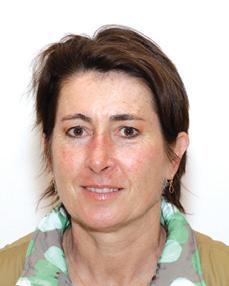
As is customary in South Korea, I deposited my shoes at the restaurant’s entrance, showed my sign of ‘Naneun chaesikjuuijaimnida’ or ‘vegetarian’ in Korean, and was ushered away from the raw beef piled high on tables ready to be stir fried, into a small room with sliding wooden doors. I settled onto pillows on the floor around a low table that was soon covered with small plates. There was soft tofu, glass noodles mixed with sesame oil, barley rice, sweet potato soup, kimchi and a large pot of green tea. Kimchi is a traditional dish made of cabbage, cucumber and radish that is popular throughout Korea for its delicious flavour and health benefits. The portions were replenished and enjoyed.










Hastily rebuilt after the Korean War, Seoul is a city of districts and neighbourhoods that house over 10 million people. The city is shedding its utilitarian image, and now has the potential to become one of Asia’s most glittering metropolises. A city of contrasts of old and new, the city centre is well planned, spotless and spiffed up with numerous recent examples of striking sleek contemporary architecture, including the City Hall with a cresting wave facade of dark glass. With attention given to public amenities, parklands have been created such as the Cheonggyecheon or ‘stream,’ with office workers taking a stroll during their lunch break. And there are many vibrant neighbourhoods showcasing a booming art scene, with the number of art galleries with quirky art on display being quite impressive, as are the fashionable stores and the thriving youth culture.
After arriving at the port city of Incheon, I travelled to the city centre, heading for one of many grand palaces dating back to Seoul’s feudal past. The city centre is bounded by five grand palaces that date back to the Joseon dynasty which ruled Korea from 1392-1910, founded by King Taejo. Gyeongbokgung Palace built in 1395, was the main royal palace for 500 years. Reconstructed in 1872 at enormous cost, it almost


bankrupted the government of the time. Monumental halls and private quarters of the royal family are splendid, but the Changing of the Guards ceremony is spectacular. Within the grounds, the National Folk Museum of Korea showcases examples of Korean life. Nearby is Cheongwadae known as the ‘Blue House,’ home to the Korean President, and so called because of its blue roof tiles. Changdeokgung Palace nearby was built in 1405 with the last royal family member living here until her death in 1989.
At Namdaemun market, with over 10,000 shops selling clothing, textiles, household utensils and food radiating out along alleyways from the centre, not getting lost was a challenge. I left clutching an assortment of souvenirs. The largest market in Korea, it was established in 1414 near large city gates built of stone. Somehow you get by with barely anyone understanding English, but with a willingness to communicate. Signs around the market read “Good for browing” (sic) and “Everything under the sun”.

My favourite place was the utterly charming Insadong, a street with a multitude of small quirky boutiques, cafés, art galleries showcasing contemporary art and photography, traditional teahouses and restaurants. Street vendors were selling dragon’s beard, fine strands of honey, pine nuts, chestnuts, peanuts and cornstarch. There were also some quirky museums including one dedicated to handbags, another to jewellery and one intriguingly, to chicken art. There were underground shopping malls and business precincts, with Samsung dominating. And many hairdressers and salons for manicured coloured nails.
For those who equate Seoul with a sprawling metropolis of skyscrapers and malls, the intimate scale of Samcheong-dong is a pleasant surprise. Much of this neighbourhood is a hilltop maze of hanoks or small traditional timber courtyard houses, some now operating as galleries, cafés and bars.
As I travelled back to the port, the bus passed row upon row of identical rectangular high-rise apartment blocks devoid of any
South Korea’s principal cities are a blend of the traditional and the modern, with kimchi for flavour
character. The economic revolution that has turned South Korea into the 11th largest economy in the world, also replaced many of the traditional hanoks that were once commonplace.
I next travelled to South Korea’s second largest city and the 5th largest container port in the world, Busan. Here, the lively Jagalchi Fish Market that began as a collection of fishing villages, has no nonsense women selling the freshest of fish. Views from Yongkusan Park of the city skyline were spectacular, though the highlight was Beomeosa Temple dating from AD678, set against a mountain setting requiring a steep uphill hike. Mountains cover 70% of the landmass, making Korea one of the most mountainous regions in the world. South Korea may be among the most wired and densely populated
countries in the world, but its first religion many centuries ago before the arrival of Christianity and Buddhism, was based on the worship of mountain spirits. Here among temple buildings wedged into the rocky terrain, I was treated to expansive views of the surrounding forest of maple and birch, towards the sea beyond. A young monk in grey robes beat a drum larger than he was, with the deep sound echoing far beyond.
I ascended to a hall filled with golden statues of Buddha, and met a college student who was staying at the temple overnight to learn more about Korean culture.
On my return home, as I was having my hair cut at the Bondi Junction salon managed by Soon from Seoul, I mentioned my visit. She slowed down the snips of her scissors that always performs at top speed and paused. “But did you try kimchi?” she asked.
Asiana Airlines has direct flights from Australia, with several Asian airlines including Air Asia, Cathay and JAL having one stop en route.
GETTING AROUND
Extremely tourist friendly, the subway system is colour coded, efficient, inexpensive and easy to navigate. Hop on hop off tourist shuttle buses go to places of interest. Busan is just over 2 hours from Seoul by fast train.
The 185-room Park Hyatt Seoul T: 82-2-2016-1234 W: seoul.park.hyatt.com occupies a glass and steel building in the central Gangnam district. For a luxury stay in a traditional house, the Rakkojae Traditional Korean House (Hanok) is recommended W: www.rkj.co.kr In Busan, Haeundae Grand Hotel, Haeundae Beach is 5 star W: www.haeundaegrandhotel.com, while Apple Guest House is a good budget choice. W: www. appleguest.com. There are also many affordable traditional guest houses, youth hostels, home stays and temple stays. For a comprehensive listing go to W: www.visitkorea.or.kr
MUST TRIES
Kimchi is a traditional fermented side dish made of cabbage and vegetables, thought to have curative health properties.

FURTHER INFORMATION




Korea Tourism Organization, Level 18, Australia Square Building, 264 George Street, Sydney Ph: 02-92524147 W: www.visitkorea.or.kr has maps, brochures and helpful staff. There are many Tourist Information Centres in Seoul and Busan with roving staff providing assistance in English at tourist venues. Walking tours are provided by volunteers. A 24/7 phone interpreting service operates and information can be downloaded onto your smart phone. Currency is the Won, with 1AUD = approx 1,000 Won at the time of print.
Clockwise from top left: Changing of the guards, Gyeongbokgung Palace

A Seoul local Jagalchi Fish Markets
Beomeosa Temple
Textiles at the National Folk Museum


The Seoul shopping scene Insa-dong

Beomeosa Temple
A Namdaemun Market stall

South Korea may be among the most wired and densely populated countries in the world, but its first religion many centuries ago before the arrival of Christianity and Buddhism, was based on the worship of mountain spirits




 BY K ALYANI WAKHARE
BY K ALYANI WAKHARE

The year’s in its final quarter and that marks the arrival of the festive season.
When festivities are in the air and Navratri, Puja and Diwali parties are lined up, the focus is naturally on what to wear, how to accessorise and how to add the perfect finishing touches? So, is it time to reinvent your wardrobe, or simply acquire some new pieces? Why not a bit of both. And another good reason to shop? Diwali presents of course! If you have a trip to India planned then of naturally you’re in for a fantastic ethnic wardrobe shopping treat. But even if you’re not, fret not, and read on.
With a myriad of possibilities for online shopping, there’s bound to be an outfit for every taste, budget and style. Online shopping is fun, yet tricky because you run the risk of sizes not working for you, or things looking quite different in reality. Also, you have to take into consideration the delivery time if you are ordering something to wear for a special occasion. But, if you are a confident and informed online shopper you can get yourself that spanking new saree or anarkali suit at your convenience and flaunt it at your next big festive event.
If you crave Indian designer wear you probably already know about Pernia’s pop-up shop and the sensational range of Indian wear you can find at this online store. It’s hard to resist that fabulous Manish Malhotra lehenga, quirky Masaba saree or magical Amrapali accessory?
How could you not associate all things bling and shiny with festive wear? Of course, you don’t have to think twice when you pair up those gold or silver sandals with your rich saree on Diwali night. If you don’t own any, I say go ahead and pick a pair this season, with all of those mid-season sales happening. Heels are a must because they are aesthetically oh so right. Pick a lower kitten heel if you prefer comfort, or peep

toes over closed heels, as they are more flattering with a suit or saree. Even shiny wedge heel sandals, or studded flats can do the trick (making you look glamorous that is).

The variety of clutches available in the malls, markets and online are just so numerous that it has me more confused than when I started off looking. But I managed to work out the best choices for an Indian ensemble and also how to pick a classy one over the cheap and tacky looking ones!
Boxed clutches
Although impractical looking, they actually work well with festive Indian attire. You couldn’t go wrong in satin finished ones in deep red, dull gold or fuchsia, as these colours work perfectly with most Indian bright outfits. Pick a smallish one with a pretty clasp.

I’d suggest a modestly priced piece as it doesn’t have the same cost per wear as other pieces, unless you’re a party animal!
You don’t really have to be an adept online shopper for ordering accessories online, because one size really does fit all! India also has some brilliant brocade fabric boxed clutches that speak timeless elegance, so indulge in one of these.
Jewel encrusted clutches
Pretty, yet tricky to shop for, as they can end up looking cheap or over the top if you don’t find a stylish, tasteful piece. My theory in this case is ‘less is more’ and pick subtle over loud. So my pick would be a black clutch with bigger diamantes on it, or a brighter colour with smaller uniform stones ensuring to keep in style.



I’m sure you’ll all agree that there is absolutely no dearth of India inspired jewellery, regardless of whether you shop at Diva, Prouds, Myer or Kmart. There are numerous ways to mix and match silver, dull gold, faux diamonds or even pearls. The good thing about some jewellery is that it is far more versatile than we imagine.
Like large flashy earrings working with your chiffon saree, just as well as with a LBD (little black dress). As long as you allow the outfit
magic, using the jewellery to play the perfect accompaniment.
If you are tired of repeating your Indian outfits time and time again, and don’t want to shop for new ones, then here’s a clever option. I like to call it a ‘closet remix’. Combine a plain satin evening dress with your gorgeous sheer dupatta and a churidar to make a completely new outfit. Just stick to the same tone while putting items together.
I sometimes even pair linen tunics with a bandhani dupatta and salwar for a more casual day time festive event.
Be inspired to reinvent your wardrobe, or shop for something exclusive to flaunt this festive season!
My pick would be a black clutch with bigger diamantes on it, or a brighter colour with smaller uniform stones ensuring to keep in style

The next crucial stage is: THE INTERVIEWS!
Medical interviews are different from normal interviews and seek specific qualities. They happen right after your HSC exams so, for:
tuItIOn fOr MedIcal IntervIew preparatIOn
by a current 3rd year medical student, contact Yash on 0402 788 353 I’m experienced at interviews, having been to many myself and having tasted success not only in medical interviews, but for scholarship and cadetship interviews as well. In the last two years, over 90% of my interview students were successful in gaining entry into MBBS at universities across both the states of NSW and QLD. It’s all about preparation and knowing how to present oneself for the optimum outcome.
Make the most of the opportunity now and ace those interviews!
ALSO A FEW VACANCIES LEFT for school holiday classes for PERSONALISED TUITION FOR UMAT 2014 and HSC English Advanced

Certified Examiner / Teacher

email: warrawee14@gmail.com
0423 262 268
Migration Agent Registration Number: 1382332
• Professional skill and service, ethical conduct, reasonable prices;

• Maximise your chances of successfully getting the best visa;
• Minimise the risks of things going wrong;
• Help if your visa is refused, cancelled, expired, etc.
Australian migration law is very complex and strict.
There are hundreds of types of visas, and they are all different.
Every year, thousands and thousands of visa applications are rejected or visas are cancelled because people make mistakes. Migrating to Australia is a big decision and a big event in your life.
You don’t want to risk anything going wrong with it:
www.visaagent.com.au visa@visaagent.com.au

“EKC’s
Delhi designer Kushma brings to Australia
another captivating display of traditional hand woven sarees.
Kushma Ram spends her time between Australia and India and has been bringing Kay Collections
Saree exhibitions to our shores over the last few years. Many of the exhibition sarees have won national awards.
Kushma Ram works with weavers in different weaving regions to recreate traditional sarees using centuries-old hand loom traditions and techniques.
The handloom art form
A good hand woven saree could take up to two years to create. Weavers painstakingly work through the warp and the weft yarns, infusing designs and patterns only from memory, to create masterpieces.
The Kay Collections Celebrating Indian Silks 2013 Exhibition presents a variety of weaving
patterns on silks, which reflect the rich cultures and traditions of weaving communities.

For example, the baluchari sarees portray great romances in history, or significant events reflected in the epics such as the Ramayan
The ikat and bomkai sarees from Odisha reflect motives of plants and animals from the surroundings of the weavers. The madhubani sarees from the Madhubani district of Bihar reflect stories of changing seasons and celebrations of life.
Hand weaving is a rapidly dying art form and fewer master weavers remain today. By bringing this art form to international audiences, Kay Collections helps to preserve it.
Celebrating Indian Silk exhibition
The 2013 exhibition presents handwoven silk sarees from Benares, Bengal, Kanchipuram and other weaving regions. All sarees are unique to this exhibition.
Seeking suitable match for fair and young looking Hindu lady, 5’ 2”, 55, divorced, vegetarian, Australian citizen. He must be a non-smoker, ideally aged between 50 and 60. Please contact: 0449 623 316 or email alpine_rhapsody@hotmail.com
42-year-old Fiji Indian Hindu divorcee with no children. Teacher in Fiji with sober, pleasing personality. Father is retired principal, mother is domestic living in Fiji. Would like to seek groom 40-50 and settle down in Australia after marriage. Contact uncle/ aunt in Sydney: pushpalal007@optusnet.com.au
35-year-old Fiji Indian Hindu single with BA
Economics working in university in Fiji, with simple, sober personality, would like a groom aged 35 to 40. Parents are retired teachers living in Fiji. Would like to settle in Australia after marriage. Contact: uncle/ aunt in Sydney: pushpalal007@optusnet.com.au
Seeking suitable match for 36-years-old who works for a multinational company in a senior position (chartered accountant), who values both Indian and western culture. Seeking Hindu
Through these exhibitions, Kushma Ram presents the diversity, vibrancy and unique traditions of India seen through the eyes of weavers and that Kay Collections works with. The exhibition is an event for the whole family. It is an opportunity to learn about the
professional man, preferably from a well settled family background. Please contact: ganesh2011v@gmail.com
Suitable match is sought for remarriage of a professionally qualified, fair and beautiful Khatri girl, 33, 5’ 2” from well-educated and cultured Hindu Punjabi family. Girl has been a lecturer at a university in Jalandhar for the past four years. She is sweet natured and brought up with good family values. Boy should be well settled in service/ business and be a permanent resident/ citizen of Australia. Email: Jk.khanna5@gmail.com

Fiji Indian male, Hindu, Australian Citizen, mid-forties invites correspondence from single or divorced Indian females (no kids) for marriage or long term relationship and to settle in Melbourne. If interested please contact: 0478 083 457 for further info.
Seeking a well-educated good looking girl for a handsome Hindu Khatri boy, 29-years-old, 5’10”, Australian national settled in Melbourne. He is a finance professional working in a managerial capacity with a reputable firm. Contact: melgroom2013@gmail.com
different weaving techniques and how they are used to capture moods and events.
These exhibitions play a small part in presenting Indian culture to Australian audiences and making its contribution to preserving the fast disappearing art form.
Exhibitions
10am-7pm, 11-13 October 2013
Quality Suites D’Olive View 454 Point Cook Road Point Cook, VIC
10am-7pm, 25-28 October 2013
Waverley International Hotel 301 Springvale Road
Glen Waverley, VIC
So you have a passion for writing…. Indian Link Newspaper is seeking reporters in your city, to cover Indian community events, as well as India-related events in the mainstream.
We would like YOU to be part of our exciting growth! Appropriate remunerations paid.
Would you like to be self-employed, operating your own business within your family home? Are you motivated and skilled to care for and educate children? Are you seeking a career that allows you to earn whilst caring for your own children or be your own boss? Then becoming a Family Day Care (FDC) educator may be the unique career opportunity for you.
hours: Flexible – Educators can set their own days and hours of operation
Qualifications:
• Preferred childcare industry experience with relevant qualifications. However, we will also consider those who have some experience and are willing to study minimum of Certificate 3 in Children’s Services.
• Current First Aid / CPR certificate
• Current Asthma & Anaphylaxis certificate
• NSW Working with children check, ABN
Looking for educator in blacktown, penrith, hills district, parramatta, Merrylands, bansktown, auburn, strathfield, ryde and surround areas. phone: 02 9637 0612 or email: info@sweetangelsfdc.com.au









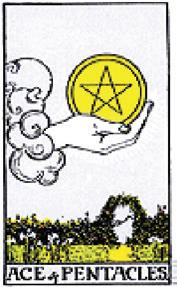



This month the cards are indicating a time of stress over love and relationships. You seem to be feeling rather disappointed with a certain situation. There will be some fabulous changes with your working pattern and a much awaited promotion or increase in finances. Take care of your health as you seem to be stressing yourself out. You feel that you want change your life drastically.

You will have a tendency to be a little blunt this month, so it would be a great idea to try and take a deep breath before you deal with people at work and/or officials. The cards are advising you to have a dental check up and also look after your stress levels. Meditation and deep breathing exercises are recommended. Relationships will need your tender love and attention this month.
This is a month for you to look at your work and health area. You need to decide on what you want to do as you seem to be bored with your normal routine. You have been thinking of moving on, but your actions are not in focus. Look at doing some yoga for your body, as you also seem to be suffering from aches and pains. There is a feeling of wanting to travel more, so book a short journey to explore nature and walk more.
This month the cards are showing that you will be looking at investments. Look at every detail and take your time. The second part of October looks packed with several trips and associations with people who will be instrumental in your future growth. There may be some talk about moving this month, as you need a change. Take time out to spend time with your close friends and family.
The cards are indicating a time when you will be finding your married life stressful and difficult to handle. You need to sort things out with each other as there seems to be distance between you. Look at your working hours. A short break away will help the situation. The health of elderly members of the family may be a concern. If you have children, there will be some good news with exams and awards.
This month is filled with celebrations and parties. Take some time out as you have really been overdoing the social scene. A new member of the family, either by marriage or birth, may be a bit challenging. The cards are showing a time of making new contacts and friends. This is a time for a lot of new energy to flow through your life.

You will be travelling around a few countries, visiting relatives and friends. Older Librans may be thinking of retiring in another country. There will be some news about a new baby or marriage which you will be attending. There will be an interested party who would like to buy your property. Look after your eyes.

You seem to be feeling exhausted and tired this month. You need to relax and take more time out for your own healing. Take proper rest. Matters will be sorted out and you will be back to feeling good again. You may be asked to speak at a meeting or conference, and you will do exceptionally well so do not get stressed.
sAgITTARIus
This month will be full of high expectations and you will be buzzing around with ideas to take forward. Your partner may not be as supportive as you will be spending more time away from home. You will be feeling enthusiastic and very fired up. Sit down and put your plans on paper and think them through. There are some amazing results if you just focus on what you want to achieve.
The cards are showing that you will be trying to get all your matters sorted out. You will be moving in to a new home or office where the energy will be very positive. There is a definite feeling of new beginnings. Love will be a lot more balanced as you will be more appreciated and feeling good about yourself. Financially things will be improving too.
You will be extremely busy with work and matters relating to paperwork. You need to make sure that everything is filed on time and that nothing is left undone at work. There is time for leisure as you will be either returning from a break or planning one. You will be very interested in planting new flowers and shrubs in your garden. Being with nature is very important for you this month.
You will be feeling a bit stressed out this month and are advised to take deep breaths and relax. One of your family members will be feeling unwell, but it is nothing serious. It’s time to take up some new sporting activities to get yourself out in the fresh air and move your body. You will be looking at changing your diet too.
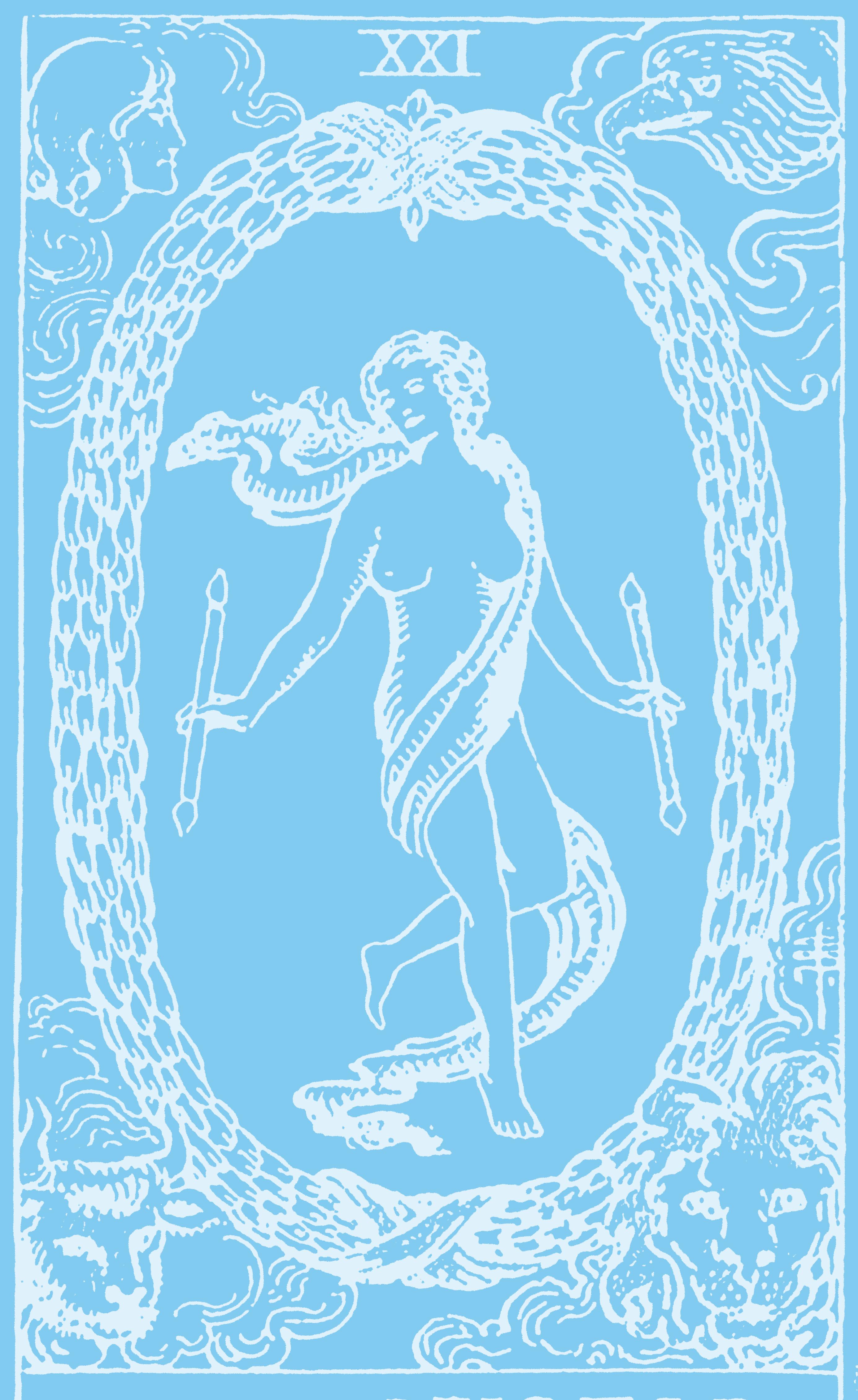
In Mrinal Sen’s Khandhar, desolation was defined and epitomized as much by Shabana Azmi’s face and physicality as it was by the architectural ruins where Sen shot his dirge-like tale. In The Lunchbox, debutant director Ritest Batra, is this really his first feature film?! does not seek easy escape routes for his characters’ destiny of drudgery.
The film is set in the heart of Mumbai where everyone is busy making a living... or just trying to live. Right away, this extraordinary film catches your attention with the way the sounds and the relentless rhythm of that City That Never Sleeps are captured and put on screen.
While remaining purely cinematic, there is something completely ‘noncinematic’ about The Lunchbox
It is stripped-down of all affectations. The secrets of lonely hearts are not laid bare through conventional cinematic devices - the use of background is so sparing that you often end up listening to the music inherent in everyday routine: the way the trains move in the sweltering afternoons, the sound of auto-rickshaws bustling through by-lanes, the sizzle of onions frying in a suburban kitchen, the sound of the television playing as a nuclear family of three lonely people dine in deathly silence.
Not just Ila (Nimrat Kaur), the cooking, cleaning suffering housewife, even her preoccupied husband (Nakul Vaid) seems so lost in the act of existence. Even their little daughter looks so forlorn with her rag-doll, as though she needs a good cry but is not sure if Mama will be there to console her.
And to scare you there are whispers of a woman jumping to her death with her daughter. Ila won’t... never! Right?
Holding back the rituals of grief is a well-worn suburban ritual that Batra’s screenplay understands only too well. Every individual in Batra’s universe is disconnected from an inner tranquillity and distanced from the people around him or her.
It is no coincidence that Ila, our forlorn

heroine who thinks of suicide but holds herself back, connects the best with an unseen aunty living with her comatose husband in the floor above. Aunty (Bharati Achrekar giving a vigorously expressive performance through her voice alone) never turns off the ceiling fan that whirrs above her inert husband, fearing that if it stops, so would his breath.
These little life-asserting pretences we indulge ourselves into believing that we lead meaningful lives, is the crux of The Lunchbox. Hence Ila strikes up an illusory bond of empathy with the almost-retired office-goer Fernandes (Irrfan Khan).

It starts off with a wrongly-delivered dabba to a lonely widower in a typical non-government office.
The initial delight of two strangers communicating facelessly soon turns into an intriguing relationship of empathy. The tragedy of two lonely people, one married in a loveless partnership and the other still wedded to his dead wife’s memory and bonding over burp-inducing tiffins filmed with gourmet dishes, is punctuated by the omni-presence of an annoying intruder, played by the very wonderful Nawazuddin, who keeps barging into Fernandes’ meditative melancholic interactions with his faceless culinary benefactor.
Among the three protagonists, Nawazuddin as the deceptively shallow Sheikh has the toughest role. He must seem frivolously jovial and insensitive to Fernandes’ lonely existence, though he is anything but these things. Further, he has a happy life. And that should and does fill him with a guilt he cannot express.
In many ways the bond that grows between Fernandes and Sheikh is far more tenable and real than the one Fernandes discovers in the aroma of the
freshly-packed tiffin that lands every day on his table.
Fernandes’ loneliness is not of the same breed as Violent Stonheim in 36 Chowringhee Lane. He is alone, trapped in memories of happiness but also surrounded by noises and smells of a normal life. That little contact he makes with a family in the building opposite his own, through his window, is emblematic of his empathetic solitude.
Yes, this man has hope.
Food, which contours the tragic love story of Batra’s film, is used almost as a reminder of life in the face of death. When Ila’s mother (Lilette Dubey nailing her character’s abject desolation in just two deftly-written sequences) finally loses her husband, she talks of hunger rather than loss.

Bereavement and loss affect individuals in very strange ways. What The Lunchbox says in a language that exudes the scent and comfort of the familiar is that we can strive to fill the emptiness inside us by cooking, feeding, remaining busy with motivating acts of daily gratification. But we are finally left with nothing to hold on to. This frightening thesis of existence is laid bare in The Lunchbox with compassion and warmth.
This is a sad film. But it isn’t depressing.
As the two protagonists whose souls collide and then come apart, Irrfan and Nimrat give exceptionally sorted-out performances even as their characters grapple with the chaos and complexities of feelings that alas, do not fit into compartments as comfortably as the food in a tiffin carrier.
Irrfan’s bearing suggests age that won’t accept defeat. He is a portrait of stoicism in the face of solitude. Does this actor ever disappoint?
Michael Simmonds’ camera doesn’t
miss a thing. It seems to capture every moment of the characters’ inner and outer lives merging the two levels of existence and yet keeping them apart.
I came away from this profoundly moving tale with two of the most unforgettable lines of wisdom I’ve heard in a film.
One of them comes from Nawazuddin who says: “Sometimes the wrong train can take you to the right destination”. And then there is Nimrat, so noble and restrained in her suffering within a pitiable marriage, who opines: “Very often we forget our memories because we have no one to share them with”.
The memory of food, friendship and forlornness associated with The Lunchbox would stay with me for a very long time.
Some films scream for attention. This one gets it without trying. What a gentle, tender, soft and sincere love story! He demonstrates an astonishing mastery over the craft. And yet The Lunchbox is all heart.
Nawazuddin, Irrfan and Nimrat are so much in character that you wonder if these people were born before the script.
The film celebrates the extraordinary ordinariness of their lives with a stark sincerity that takes away every morsel of artifice inherent in the act of filming made-up lives.
If this is not the best directorial debut since Satyajit Ray in Pather Panchali, then I am probably missing something vital.
And that’s what this film is about.
SUBHASH K. JHASTARRInG: Chandan Roy Sanyal, Elena Kazan, Kumar Mayank, Arfi Lamba
DIRECTOR: Ashish R Shukla
HHHHH
There are the dark unexplored regions of the psyche that experimental cinema reifies, even for an audience that doesn’t want to think while watching a film.
Prague engages in the unexplored, taking us into a world of despair and anxiety. Shot with splendid serenity, the movie has plenty of visual beauty to savour of the Czech Republic.
But secreted in the splendour are the murky secrets of human foibles which come rushing to the surface in unguarded moments of desperate anxiety.
Standing at the vortex of this psychologically disconcerting treatise on a mind that doesn’t follow what the heart says, is the enormously gifted Chandan Roy Sanyal playing an architect whose romance with structural precision mocks the crookedness of his inner world.
The more Chandan seeks symmetry in his life the more it eludes him, until there comes a time when the real and the illusory worlds come together in a stifling embrace.
Prague opens in India where the dynamics of Chandan’s inner world are manifested in his relationship with an undependable Indian girl named Shubangi and his two closest friends Gulshan (Kumar Mayank) and Arfi (Arfi Lamba) one of whom, we soon realise, is dead.

This is when we begin to realise that Chandan is losing his mind. As he and his two best friends move to Prague, the stage is sturdily set for Chandan’s descent into hell.
Each step of the character’s decline into a world of hefty hallucination is chronicled with compelling crispness. The editor uses components from the real world and the ‘reality’ according to Chandan in a play of hide and seek.
Then there are the songs, so well used. RD Burman’s Meri bheegi bheegi si in the Hindi and Bengali versions, and some achingly haunting Czech songs that recur in lovelorn loops of longing.
There are passages in the storytelling where the world of the imagination blends into the real world. The collision point where the two worlds meet is well controlled by the director, although at times you fear the narrative lapses into self-indulgence.
There is plenty in Prague where the motivation is questionable. Why does Chandan act the way he does? He
is marred by killer fish. Koi shark?!
STARRInG: Santosh Barmola, Suzana Rodrigues, Varun Sharma, Manjari Phadnis, Jitin Gulati, Sumit Suri and Madhurima Tulii
DIRECTOR: Gurmmeet Singh
HHHHH
Water waste of time! Slasher movies work best on terrafirma where girls in a state of disrobed desperation make a dash for safety. Alas, here the characters have nowhere to run to. Neither do we.
In Warning, the entire slasher genre is shifted to the aqua splendour of the Fijian water where true to its genre, characters start getting killed/wounded/ slashed/maimed.
The ladies of this uproariously funny slasher movie get to wear swimwear most of the time. No censor objection since they are in the water. And surely you can’t swim in a burqa!
But yes, you can get killed in the azure acres of silence. Water runs deep when it
The 3D format is used here in a strangely eccentric and miserly way. When you expect the water to surge towards you, there is just a flat silence on the screen. You are left wondering why those silly glasses were required in the first place.
Sigh, Life of Pi in the high seas, was so much more eloquent. Here, the water just seems to invite violence and not of a very convincing kind. The young actors seem to be in it for the all-expenses paid Fijian holiday with a bit of amateur shooting thrown in to legitimise the vacationing costs.
Everyone connected with the film does a lazy, if not altogether a lousy job. I do like to encourage new talent. And I’d like to give these newcomers the benefit of the doubt. There is very little plot only a whole lot of deep water to sink one’s teeth and other body parts in. The intended tension gets suffocating after 20 minutes.
And 3D be damned!
How much and how many times can
clearly embraces all the confusion, complexities, insecurities and insanity of his character.
The casting of Chandan’s two friends is also of the utmost importance. The cocky self-centred Gulshan played by Kumar Mayank, is the most fatally charismatic character in this intricate jigsaw of light and death. And the wimpy, whiny, overpossessive Arfi.
Elena Kazan, last seen in John Day, is forced to join her lover in his journey into hell, bringing a whole lot of tragic charm to the proceedings.
Not all of the events in the film make sense when judged against conventional populist elements. The very powerful Chandan plays an artiste on the brink. As he topples over, we get a vivid view into the abyss that separates man from madness.
Though not an easy breezy journey, Prague takes us into the heart of darkness.
What we see is a world manned by
you watch the actors jump into the deep end without losing their bearings? Some of the intended terror is plainly bland. And worse when you are supposed to be trembling in fear, you actually find yourself shaking with laughter.
Very honestly there are seeds of a killer thriller somewhere in this watery mess. But while leaving for their Fijian holiday, the crew forgot to take along the script.
Be warned. Undersea thrillers don’t work. Anthony D’Souza’s mega-disastrous Blue should’ve been warning enough. The last and only really successful water scare-fest was Steven Spielberg’s Jaws

This one comes too late and with
betrayal. As Chandan’s world falls apart, the film gathers its strength from the rubble that he collects around himself. Sometimes seeing dead people is about attempting to remain sane in a world that is defined by eccentricity and death.
Prague is a tough film to digest. But who said life in the movies is only about the unbearable lightness of being stupid?
SUBHASH K. JHAalmost nothing to offer.
If you like horror films please watch ground level slasher films. If you dig girls in bikinis please watch Baywatch
But if you like to torture yourself with mid-ocean inertia, you know where to go!
SUBHASH K.
JHA

India’s very own singing nightingale who has dominated Bollywood’s music scene for decades turned 84 recently. Known as the ‘Nightingale of India’, Lata Mangeshkar started her singing career aged 13 in 1942. In a career spanning over seven decades, the singer has sung several numbers in Hindi as well as in regional languages.
Celebrities across Bollywood wished the singing sensation congratulations on her landmark birthday. “I think there would not be even a single person across the world who would not want to wish Lataji,” said Megastar Amitabh Bachchan. “I wish her a long life. I wish she always lives among us. There have come moments in my life when I have been inspired by her”.
“Many wishes to Lataji on her birthday. I wish she continues to sing more and more. I am really blessed that I got to perform on her songs. I am glad that I have performed on her beautiful songs,” said veteran actress Hema Malini.
Yash Chopra, the late doyen of the Hindi film industry would have been impressed by the turnout for the tribute marking what would have been his 81st birthday. At an event organised by the respected filmmaker’s wife Pamela Chopra, nine actresses and his protégé Shah Rukh Khan took to the stage to showcase his contribution to Bollywood.

Rekha, Sridevi, Madhuri Dixit, Juhi Chawla, Rani Mukherjee, Preity Zinta, Katrina Kaif, Anushka Sharma and Parineeti Chopra, along with superstar SRK, to make the event a reminiscent and memorable one.
The event kick started off with Anushka Sharma walking the ramp as she paid tribute to late Nargis Dutt. Anushka donned a black sari with red bindi, while Parineeti Chopra, dressed in a heavy red ghagra choli, paid tribute to Madhubala.
Evergreen beauty Rekha came next draped in an elegant sari, while Sridevi, who is always remembered as the Chandni girl, donned a white semi ghagra sari with silver work all over and heavy jewellery.

Juhi Chawla wore a white and red semi chiffon ghagra, while Madhuri wore a transparent black sari with sleeveless blouse. The outfits were an eclectic blend of vibrant colours, sequenced handwork, dhakai arts, Kashmiri work among others.
Rani was resplendent in a pink ghagra choli with golden nathni (nose ring) minus other jewelry, while Preity wore a white lehenga choli with typical Kashmiri jewellery. The last actress to walk the ramp was Katrina who looked stunning in a brownish and cream ghagra choli. Shah Rukh, the only actor amidst this bevy of beauties, wore a black suit. Each participant remembered Yash Chopra through a small speech at the end of the show.
Rani Mukerjee was moved to tears as she recalled her association with the veteran film-maker. “Yash uncle I miss you a lot... please forgive me for not making cake for you last year as I was busy with my commitments... I miss you and we all love you,” she said.
However, veteran actress Rekha took to the stage with aplomb, grooving and delivering a dialogue from her film Silsila. Rekha, who is usually known as a very private person, displayed a different persona as she danced to the tune of Yeh Kaha Aa Gaye Hum from Silsila. Making the most of the moment, she also rendered the famous dialogue “Main aur meri tanhaii aksar yeh bateen karte hai,” as she walked the ramp.
It was a tribute worthy of the filmmaker, Yash Chopra would have been proud! RIP!
In addition to Vidya Balan and Mika Singh, even West Bengal Chief Minister Mamata Bannerjee wished Lataji birthday wishes on her Facebook page saying, “I join her countless fans across the country captivated by her golden voice to wish her the very best on this auspicious occasion”. However, the iconic singer is currently in mourning and in no mood to celebrate the day. The death of her close family members has cast a gloomy spell on the singer.
Happy Birthday, Lataji, may the coming year be a good one for you!
R Madhavan rues Indian actors lack of international exposure
R Madhavan has taken a step into Hollywood with Night Of The Living Dead: Origins. He joins the league of Bollwood’s select who have made it to international screens.
Amitabh Bachchan, Anil Kapoor and Irrfan have tasted the Hollywood flavour, but they’re clearly a few and far between. Madhavan says this is because Indian actors lack the capacity to establish themselves in an international set-up.
“We have a long way to go before actors in India can establish themselves (internationally) in a big way,” said Madhavan, who has delivered noteworthy performances in Hindi films like Rang De Basanti, 3 Idiots and Tanu Weds Manu. The multilingual star will be seen as a US marine officer in Simon West’s Hollywood film Night of the Living Dead: Origins Of Hollywood, the actor said: “Their
market and technology is completely different from ours. I don’t think Indian stars have the bandwidth to go struggle and give screen tests there, leaving everything behind here”.
Nevertheless, there’s something about Hollywood actors that makes Maddy jealous! “I think the only thing which I am jealous about is that if I was an actor in Hollywood, with all the hit films which I have, I won’t have to work for another day in my life. Even if an actor has two hits in his life in Hollywood, he will never be poor,” he said.
“Technology-wise we are almost there. But the budgets over there are high (higher). It is very tough for us to make those kinds of films in our kind of economy. But even now we do make international level films,” said the 43-yearold actor.
He has just finished shooting Night of the Living Dead: Origins, a zombie film.
“It has been a huge learning experience and it was very exciting. I was very nervous as I had never shot like that before,” he said.
Madhavan is glad that the Indian film industry and the public have “been very nice with me”. “I am just keeping my fingers crossed for the future,” he said.
“For actors like me, nothing is enough. I want a lot more than what I get,” he admits.
Well, let’s hope Hollywood recognises your talent and offers you whatever you expect. Good luck, Madhavan!
John’s for wildlife
News around hunky actor John Abraham is always interesting, and he certainly has been enjoying his share of Bollywood’s buzz. The latest on John is that he has been chosen as the face of National
Geographic Channel, and somewhat predictably, the actor says he is keen to make a film on wildlife.
“Wildlife is something that we have not attempted before. I would like to explore it... I would like to make a film on wildlife, but we have to work a lot on it. If we get a responsible producer who can produce such films then why not,” John said recently. The actor, who is also passionate about his bikes, says he is developing a script based on motorcycling.
“We are developing a script on motorcycling. It will take a year to complete it. It’s a very intense and serious film on motorcycling, for motor cycling fans. It will be a commercial film,” said John, who has produced films like Vicky Donor and Madras Cafe, which did surprisingly well at the box office.
But the actor says that he is not interested in being a part of any television show yet, as small screen formats don’t excite him. “I would not want to be a part of the small screen today. Look at the formatting on the
small screen... it doesn’t excite me at all,” John said.
However, he is in complete support of Bollywood actor Anil Kapoor’s endeavour to bring about a change on TV through his desi adaptation of American thriller series 24. “The small screen is growing and I must compliment Anil Kapoor on changing the quality of programming on the small screen. I must say he is trying to make a difference. The quality of programming should change with ‘24’,” he said.
Who knows, perhaps one day John may grace the small screen with as much charm as he does on the large screen. Let’s wait and see what comes his way!
Twin Grammy and Academy Awards winner A.R. Rahman is a firm believer in the amalgamation of technology and talent. The maestro asserted that the Indian music industry is reaping the
benefits of digitisation, contrary to the notion that technology has negative effects.
Rahman, who was in Kolkata, the first city on his month-long Rahmanishq tour, claimed that he was in favour of digitisation sweeping the music industry. He stated that it has not only made music of all forms accessible to listeners, but has also simplified the process of making music for composers.


“Hordes of music purists love to spend endless hours going on and on about how the age of digital music has completely ruined the art form, and that real music only exists in small, underground scenes,” Rahman stated. “However, the reality stands that thanks to these technological breakthroughs, for both the music fan and the music maker, the creative process and the act of listening to music are now easier, less constrained and more accessible than ever before,” Rahman noted.
“We are living in a society that is dominated by the digital age. So it is a natural progression that almost every element beautifully syncs together. We need to move beyond album covers,” he observed. On his tour that will also cover Visakhapatnam, Jaipur and Ahmedabad, Rahman hopes to give fans a chance to experience his music at its best, musically and technologically. “The concert capitalises on innovative neverseen-before technology, so that the audience can be overwhelmed with such knowhow at every stage of the concert,” said Rahman.
Freida Pinto or Paris Hilton in Marchesa?


Share your views with us on our Facebook page
Rahman reckons film music “is going to be one of the biggest industries in the world. In India, we have a pool of talent which requires professional channelisation to make this industry as colossal and independent as the film industry. While India has singers in every street, many of them performing Carnatic, or classical Indian music variety, the future lies in Indian cinema,” he claimed. Loved by audiences for juxtaposing different musical styles, Rahman, who became the first Indian to win the Golden Globe Award in 2009 for best original musical score in Danny Boyle’s movie Slumdog Millionaire
What’s the chitchat between Amitabh and Mithun?

Send in your responses to win@indianlink.com.au and win a surprise prize
LAsT IssuE CApTION CONTEsT wINNINg ENTRy
What’s Aish Bachchan saying that’s making Hugh Jackman laugh?

Aish: Where’s your yellow spandex Hugh?
Hugh: How do you know it’s not under my suit Aish?
Rajesh Singh
Curl Curl, Sydney
Rajesh wins a ticket to new release Besharam

Phone calls from call centre operators have been the bane of my existence for some time now. They ring on my landline at the most inappropriate of times, like just before the school drop off or pick up, and invariably at mealtimes, interrupting my daily yell to get the TV turned off and hands washed.
A ringing phone is something that’s hard to resist and being techno-challenged, I can’t quite find the ‘ringer off’ button on my phone. If I do, it’s likely that I won’t remember how to turn it back on again. So to keep life simple, I just don’t try. This warped philosophy allows persistent call centre operators to try and talk to me about everything from solar panelling, new phone plans, cheap calls to India, sorting out my computer problems, and of course, invitations to free dinners and seminars.
I’ve tried everything from blocking my number to pretending I can’t hear them, to just not answering the phone after 5pm, but I sometimes have to bow to the inevitable and endure a frustrating conversation trying to convince them that what they’re offering is of no value, or interest to me whatsoever.

But recently, I inadvertently came across a new weapon. The phone rang as usual at 5:15pm on a Monday, while I was busy getting dinner organised downstairs. As the hands-free was upstairs, I asked my older son to answer it.
“Hello!” he bellowed into the phone, probably creating a sizeable crack in the caller’s eardrum. The phone was on its speaker, so I could hear the conversation.
“Is your mum home?” asked a male voice, somewhat testily.

“What?”
“Is – your – mum – home?”
“Vhott?” Even louder.

“Your MUM. Is your mum home?” asked the voice, practically yelling this time.






“Huh? Whaat?”

“YOUR MUM!”
“My mum? My mum?” As if he had any other!
“Yes, yes, your mum!”
“I can’t hear you, did you say my mum?”
being told off by his dad, who had inadvertently called the landline one day and had been treated to a few vociferous ‘What’s’. He had taken pains to explain the fundamentals of politeness, especially when communicating with unknown people over the phone, some of whom mum works with. Apparently some of that had indeed, made sense.
“Please can I speak to your
“How are you?” asked a suave voice.
“I’m okay, how are you?” asked my son, polite for once.
“What’s your name?”
“I’m Sid, what’s yours?”
Now this is still a hotly debated subject. Did they say ‘Matt’ or ‘Bert’? Whatever it was, my son burst out laughing hysterically, “Butt, Butt, his name is Butt!” he yelled joyously and his younger
I’m now thinking of enlisting the younger one to the task, particularly because he has his own charming brand of eccentricity that lies only within the comprehension of close family. He has ‘opposite’ days and ‘repeat’ days, among other strange and hilarious traits like wishing people ‘Happy Birthday’ when it’s the New Year, and vice versa. I can just imagine the conversations.
“Hello!”
avatar.
At this point I would take the phone from him, and if the caller is still on the line doubting their sanity, I would take at least a couple of minutes to actually listen to their selling spiel. They would need convincing that the world is, as they know it, a normal place. So that they could hang up and confidently move to the next caller… you, I hope!
“Mum? Who?”


